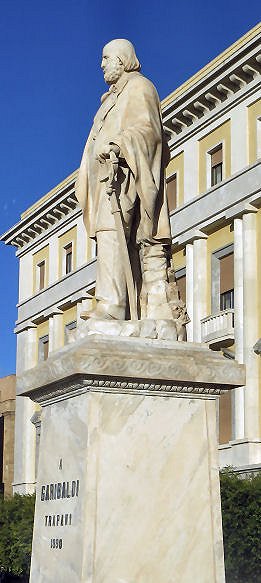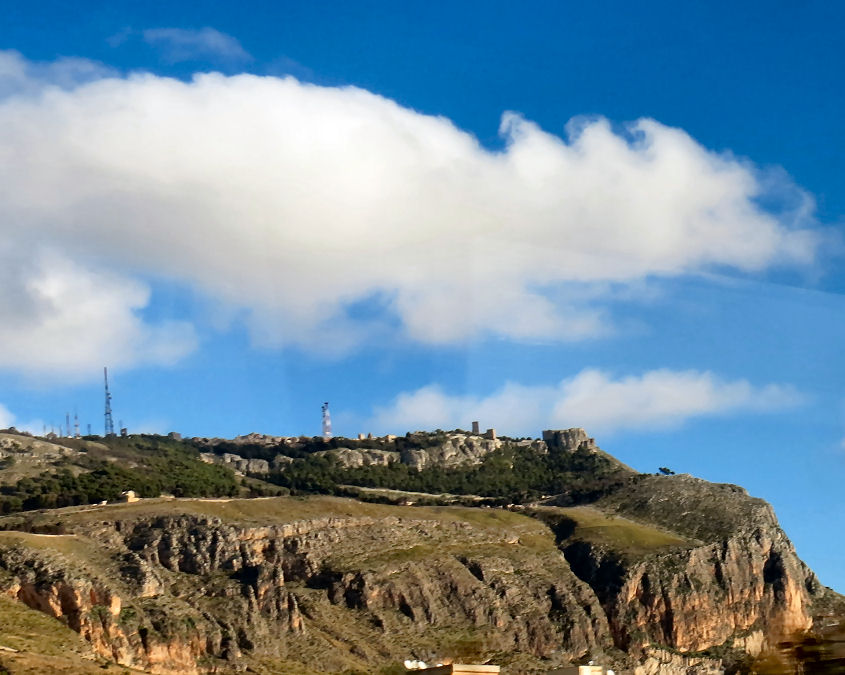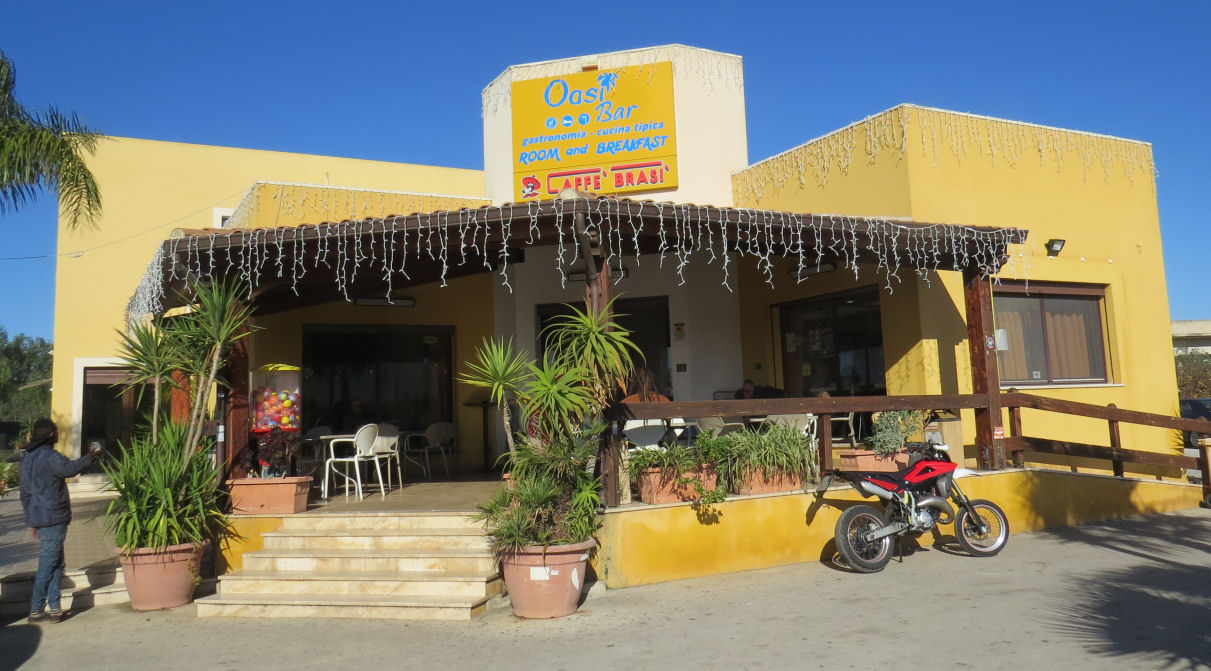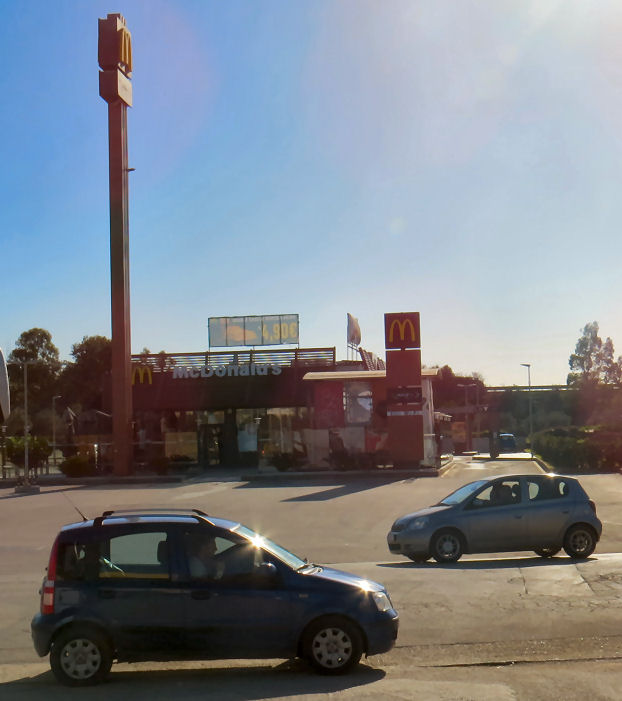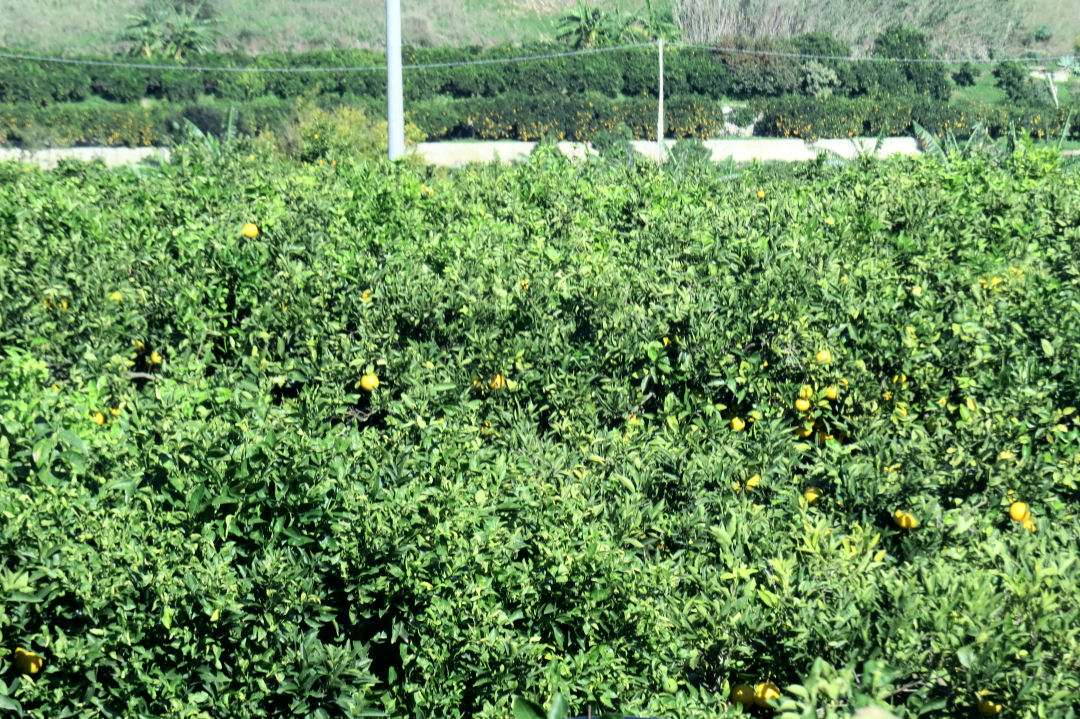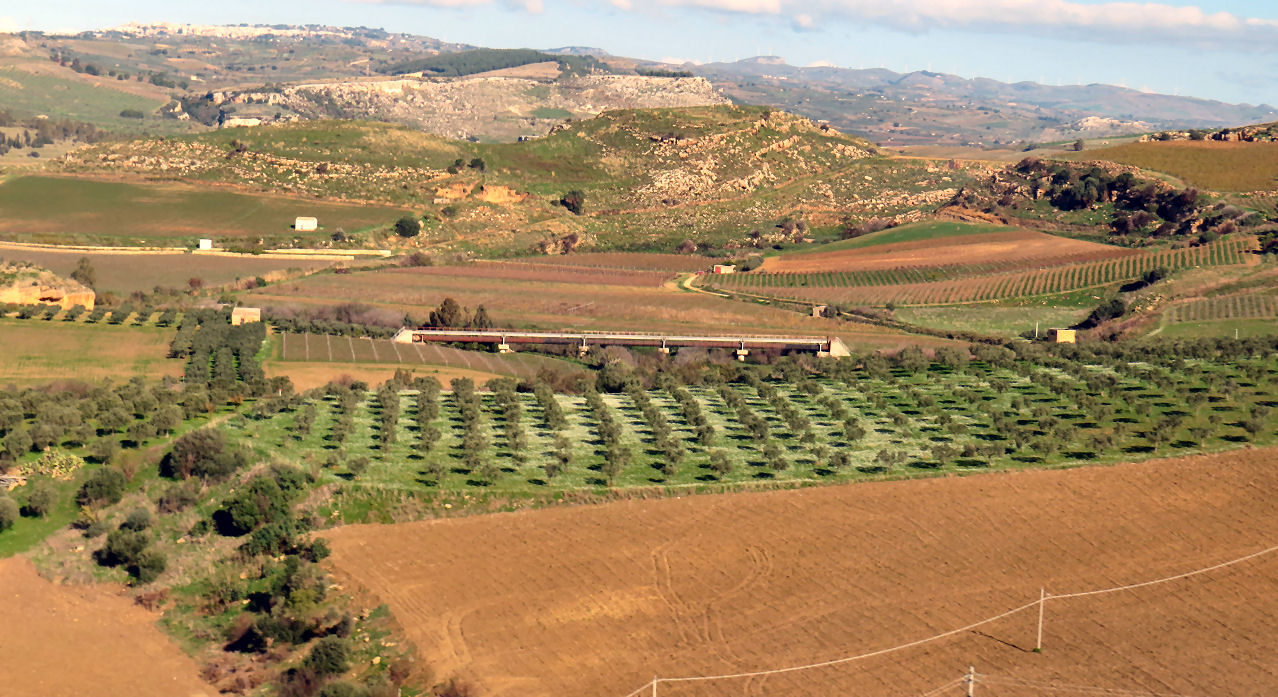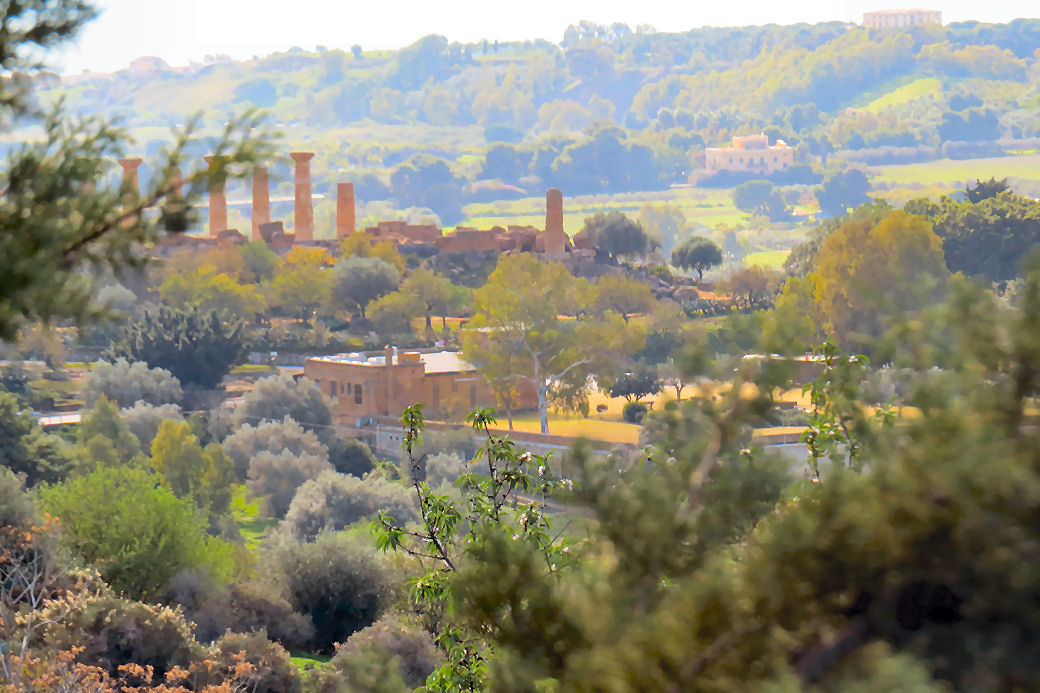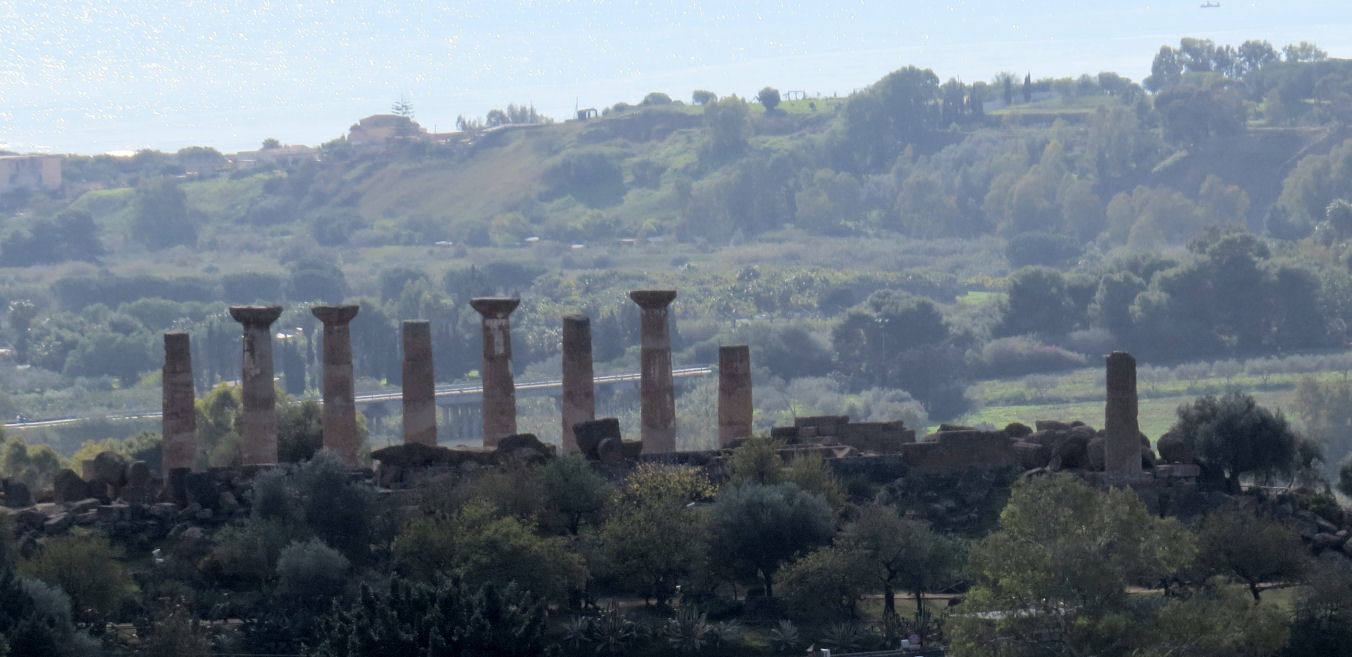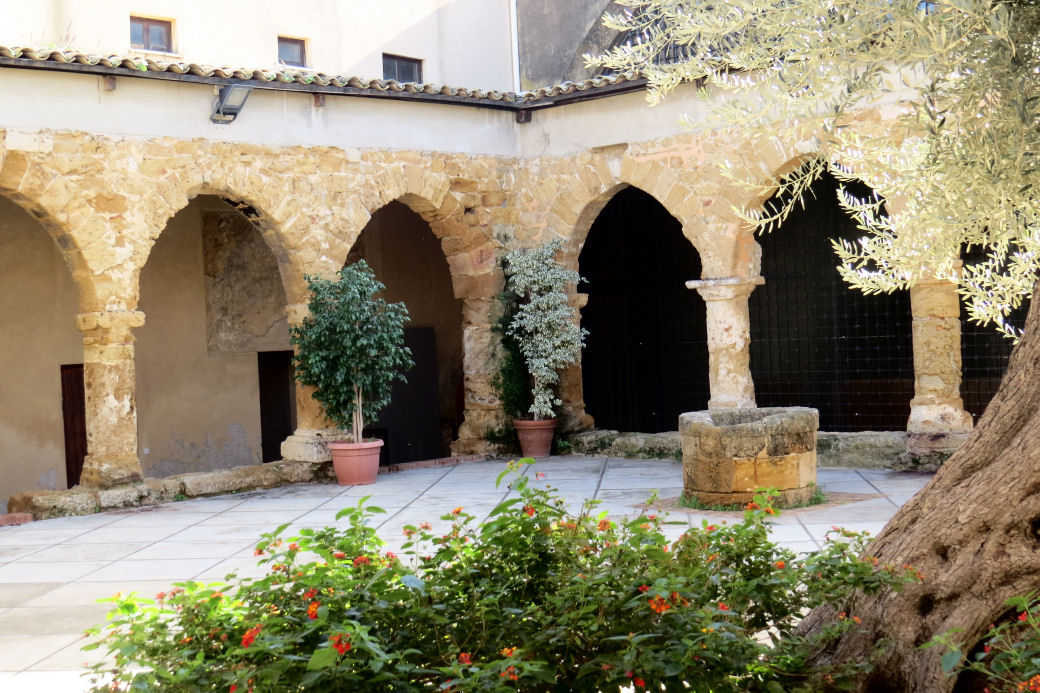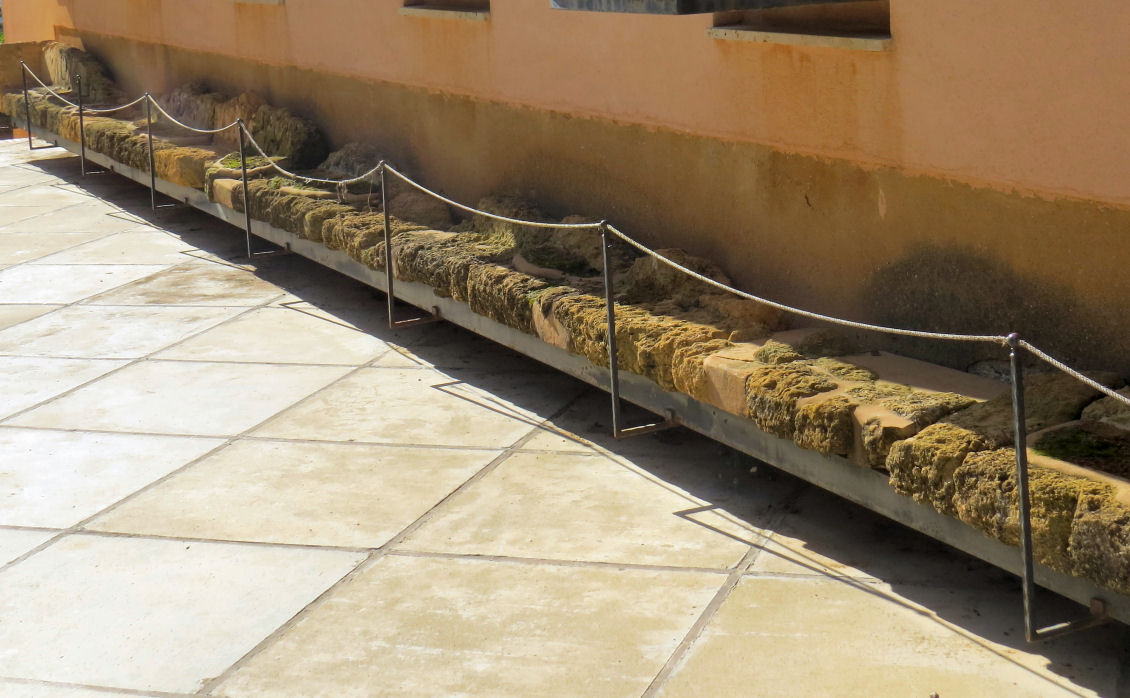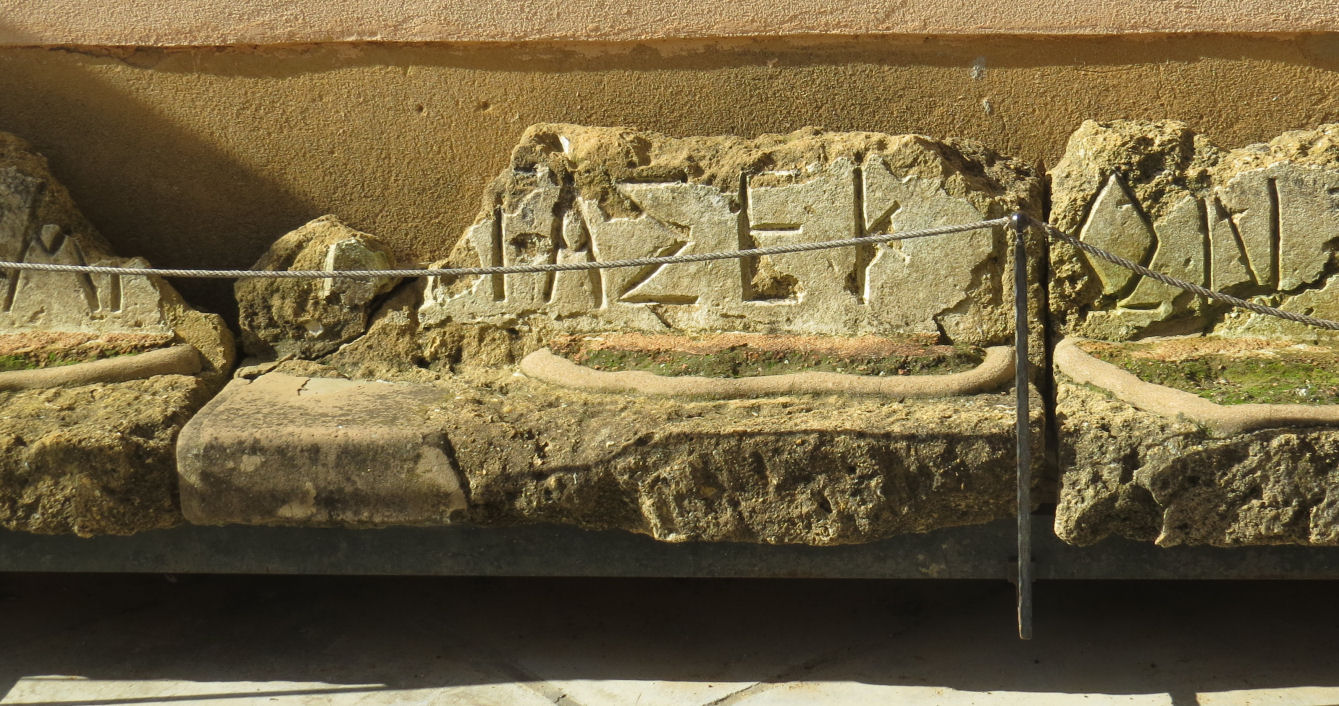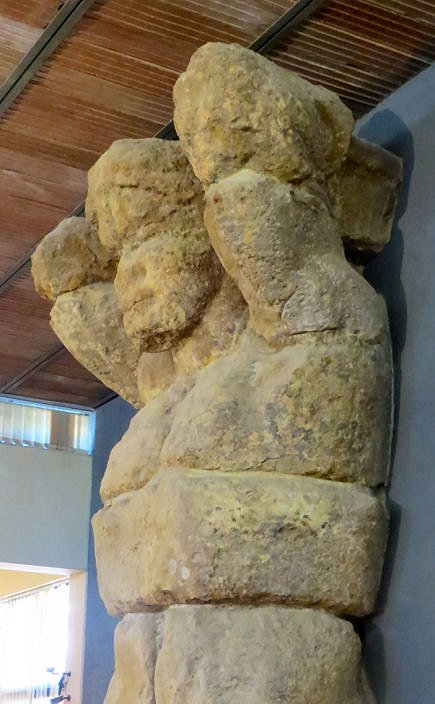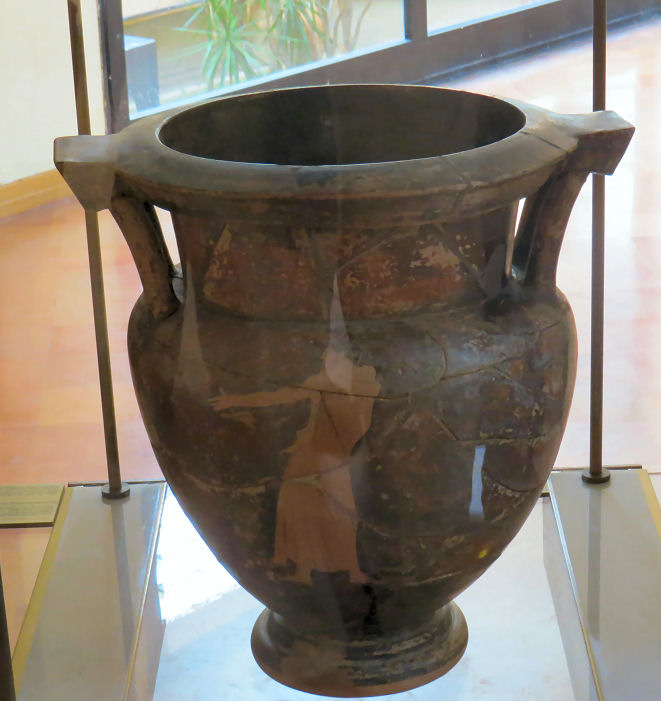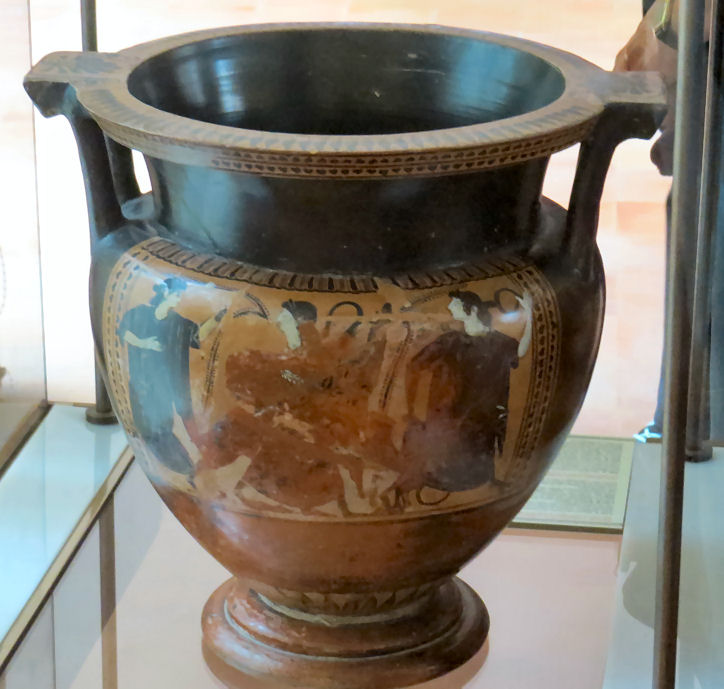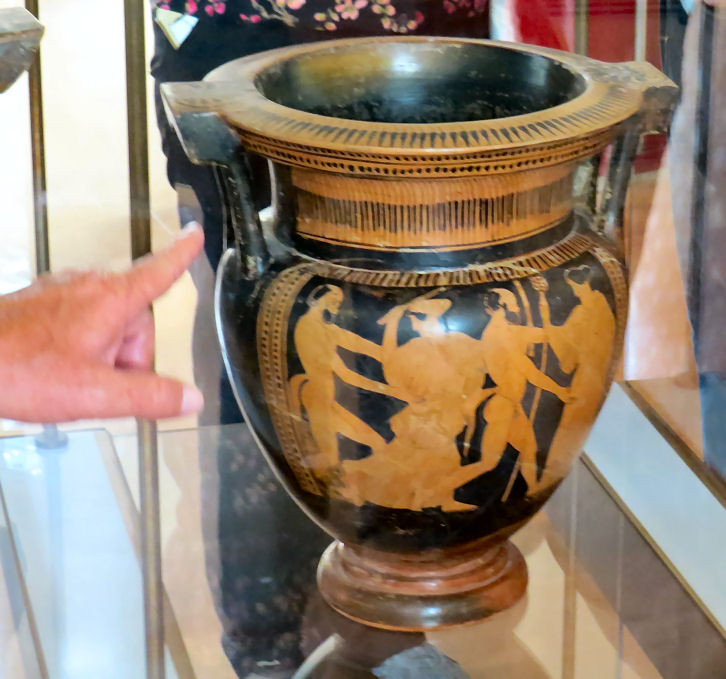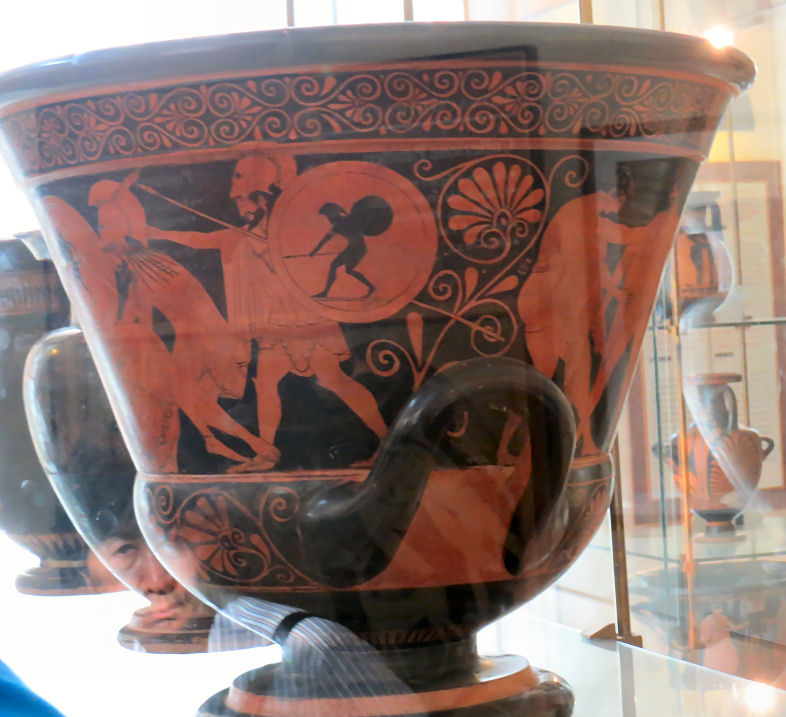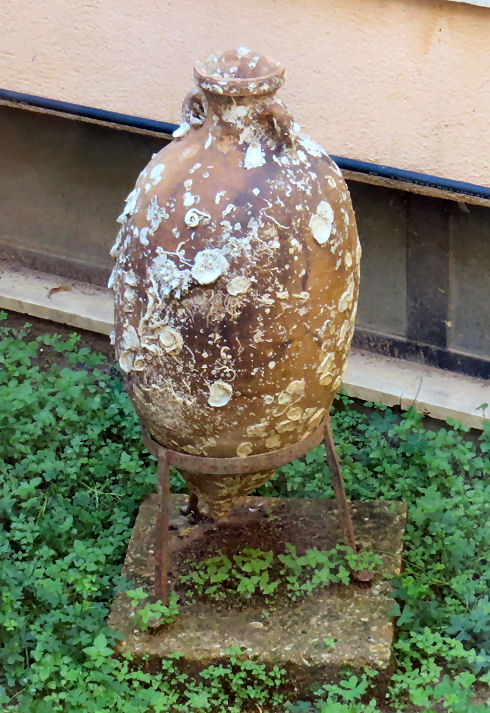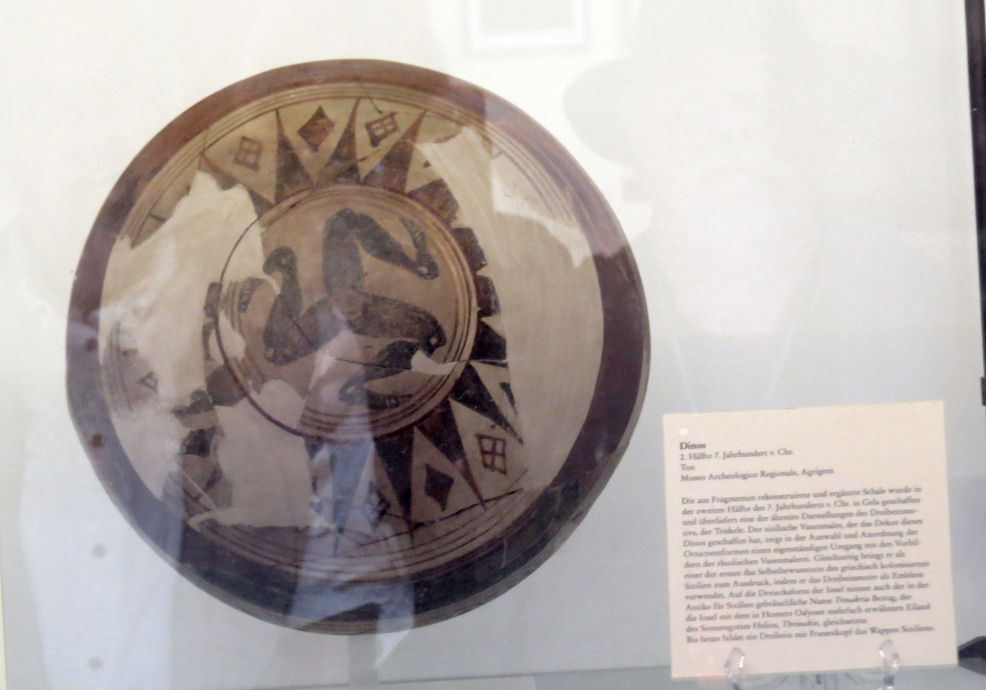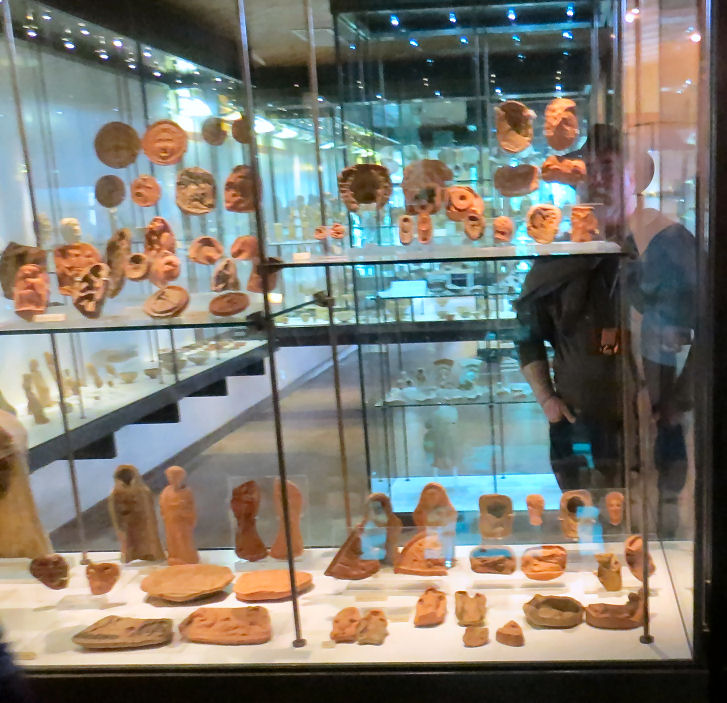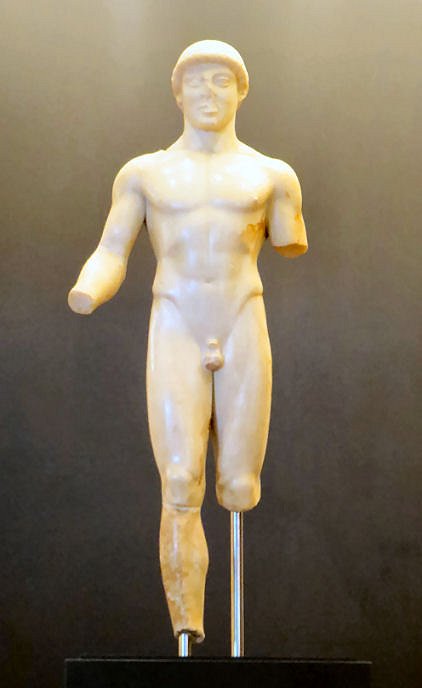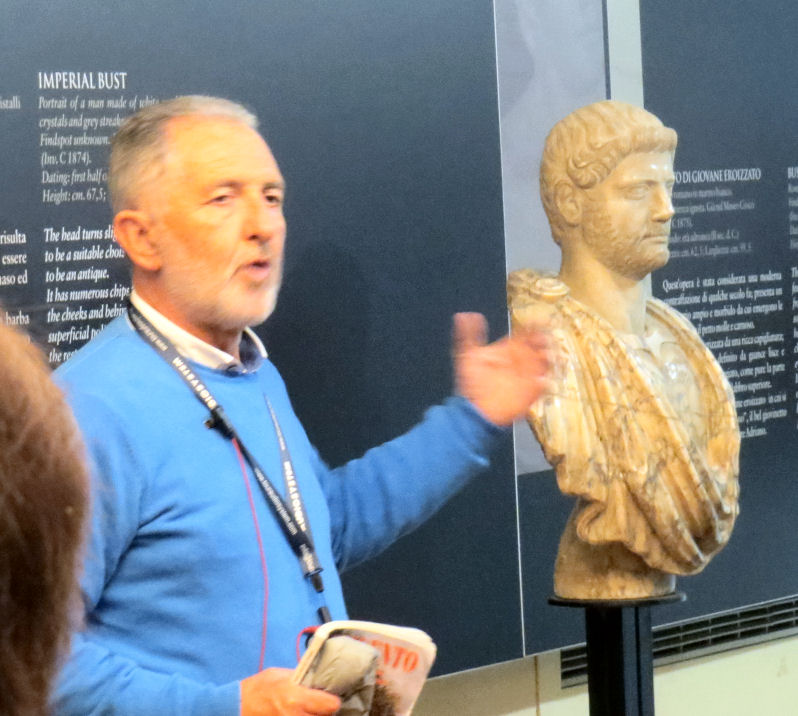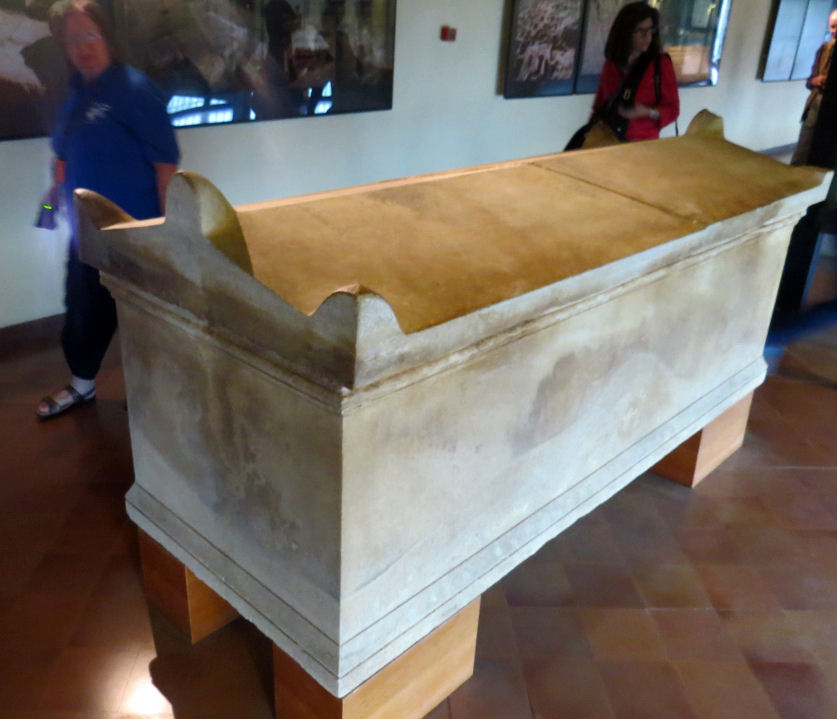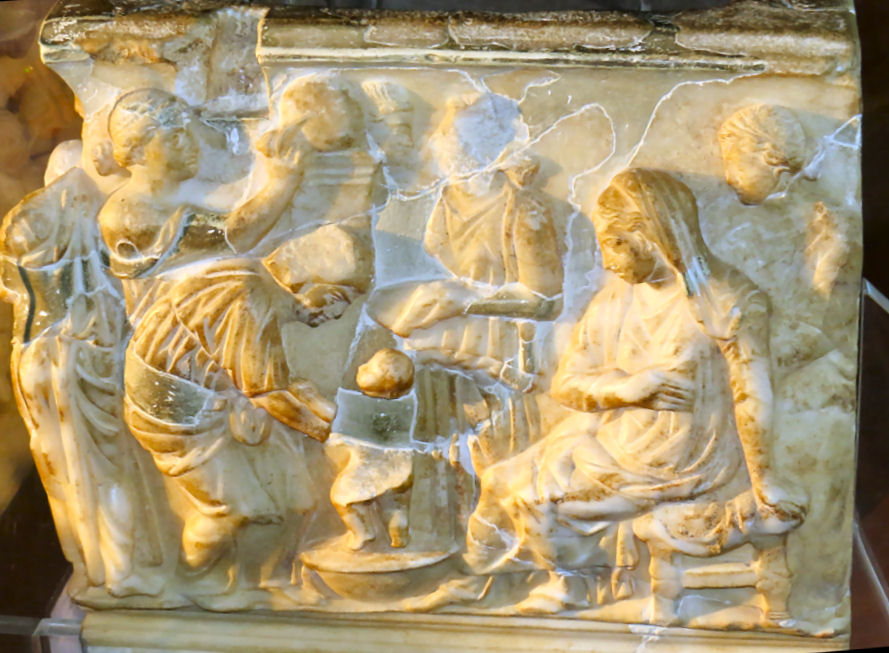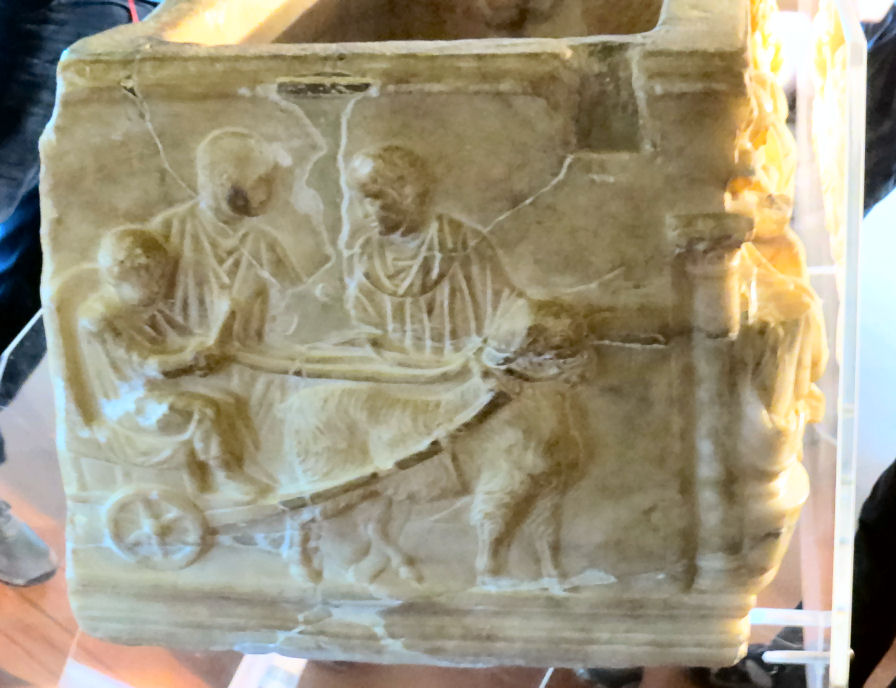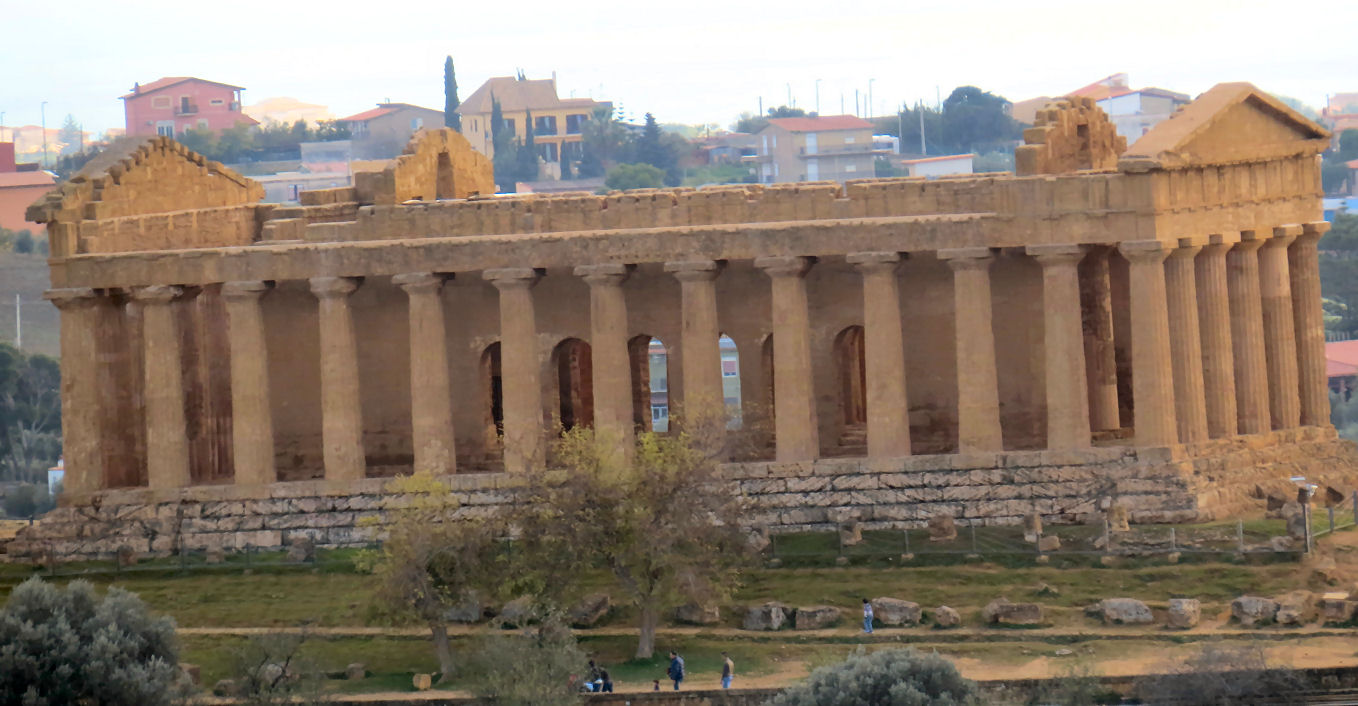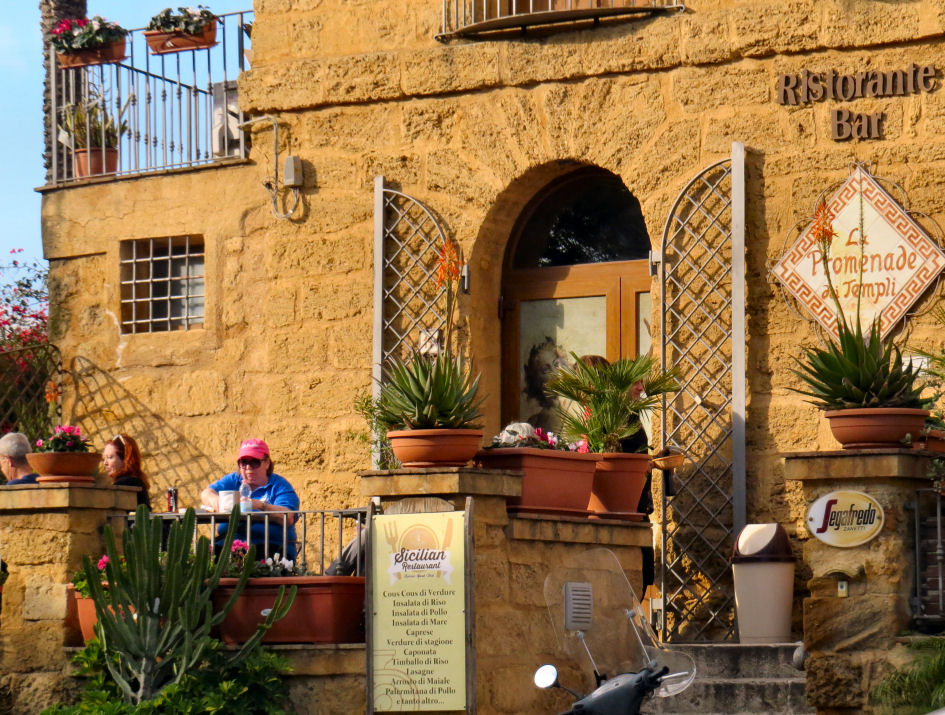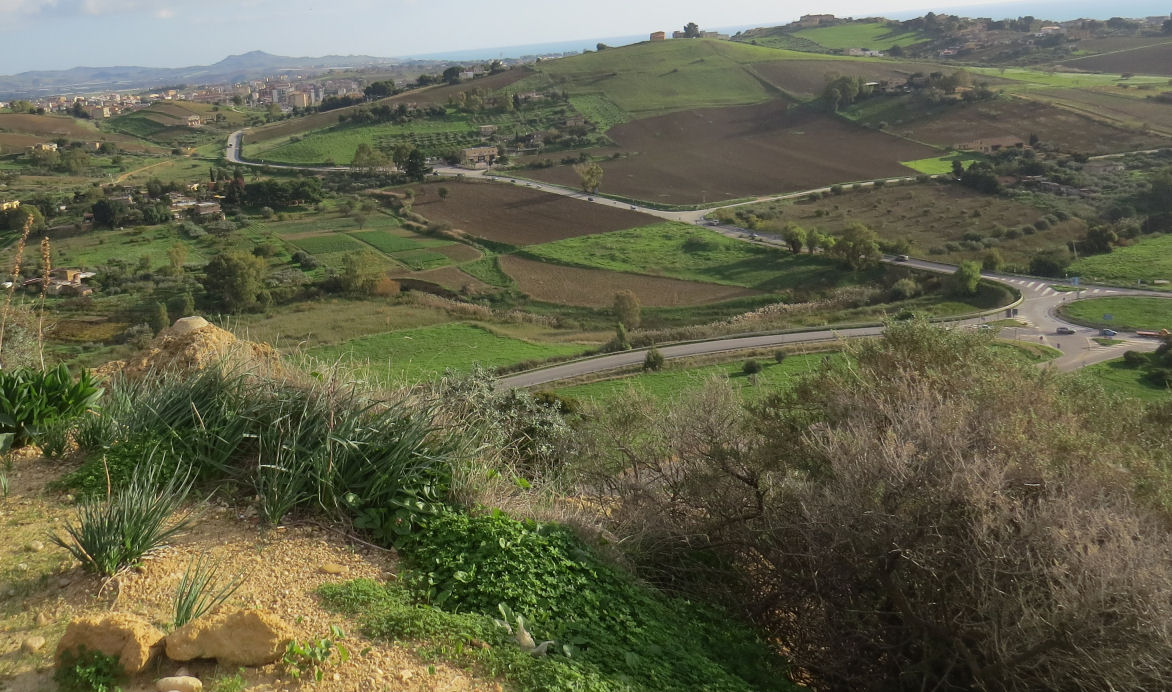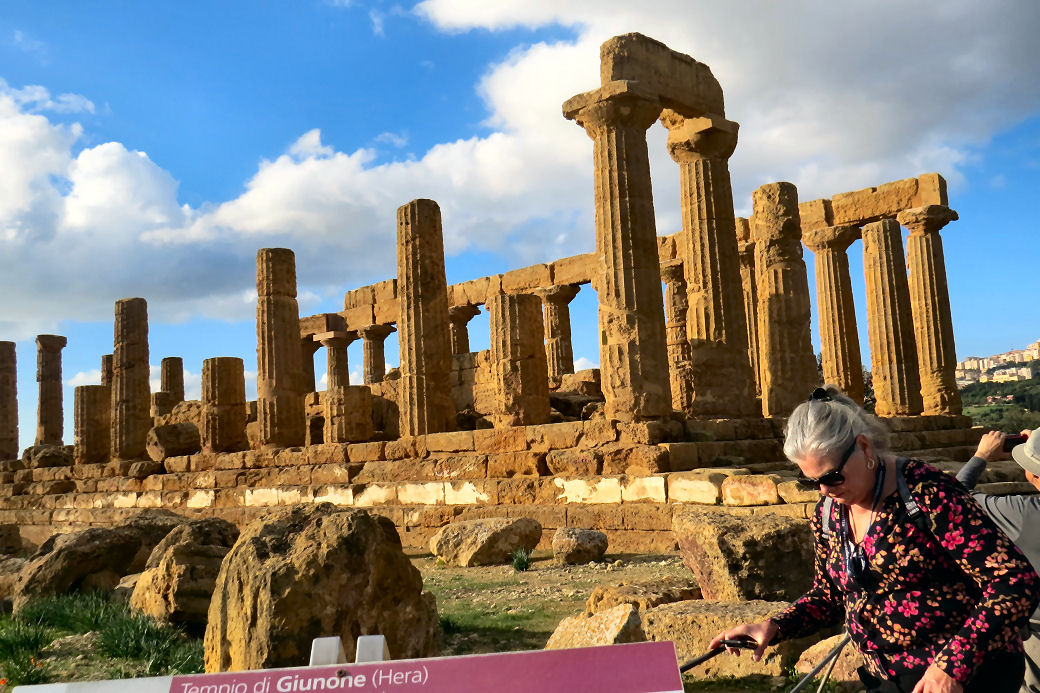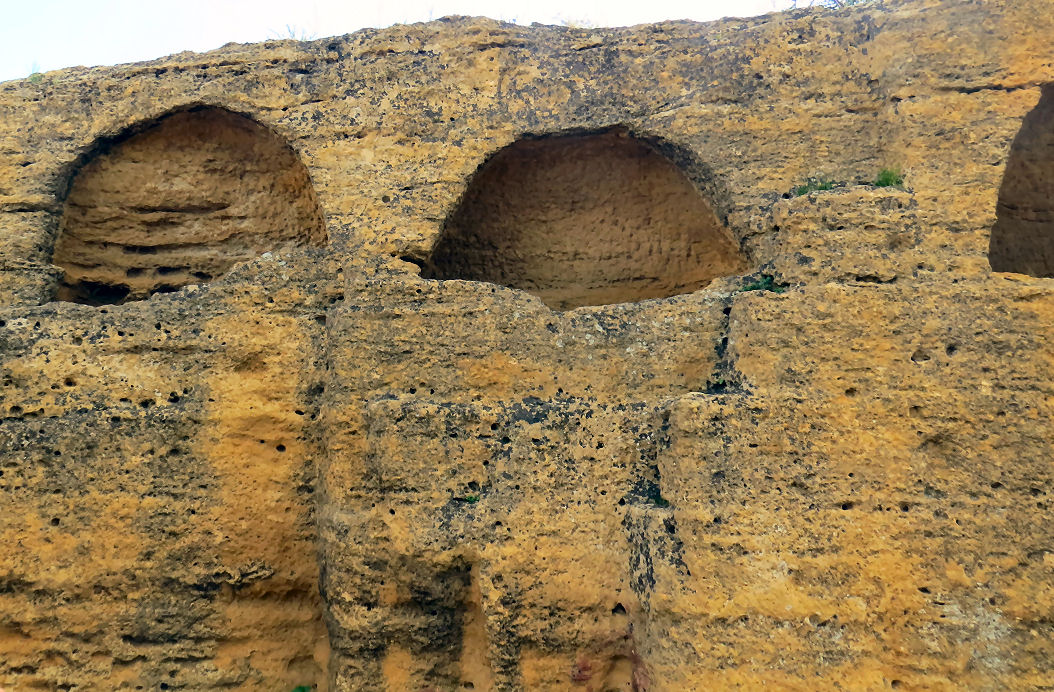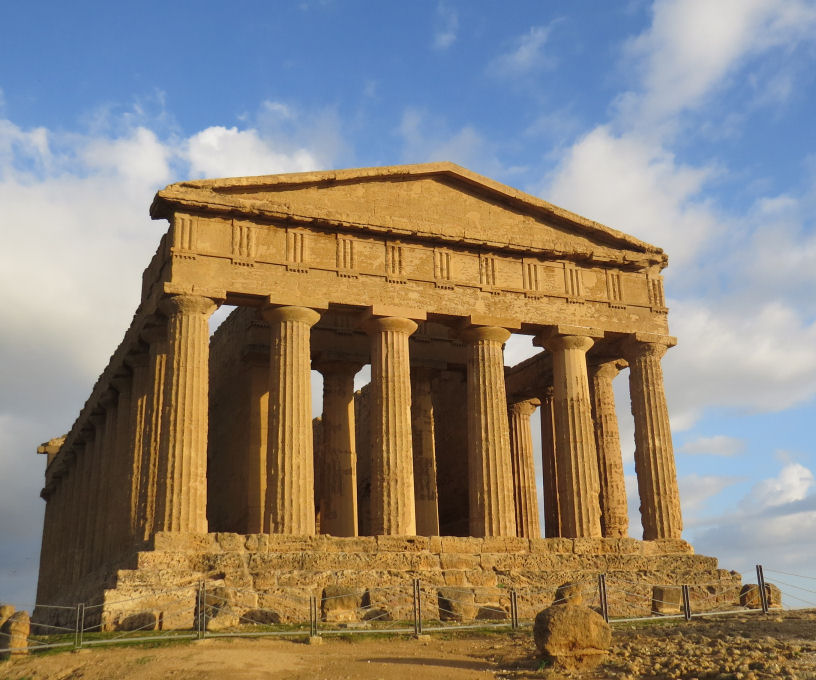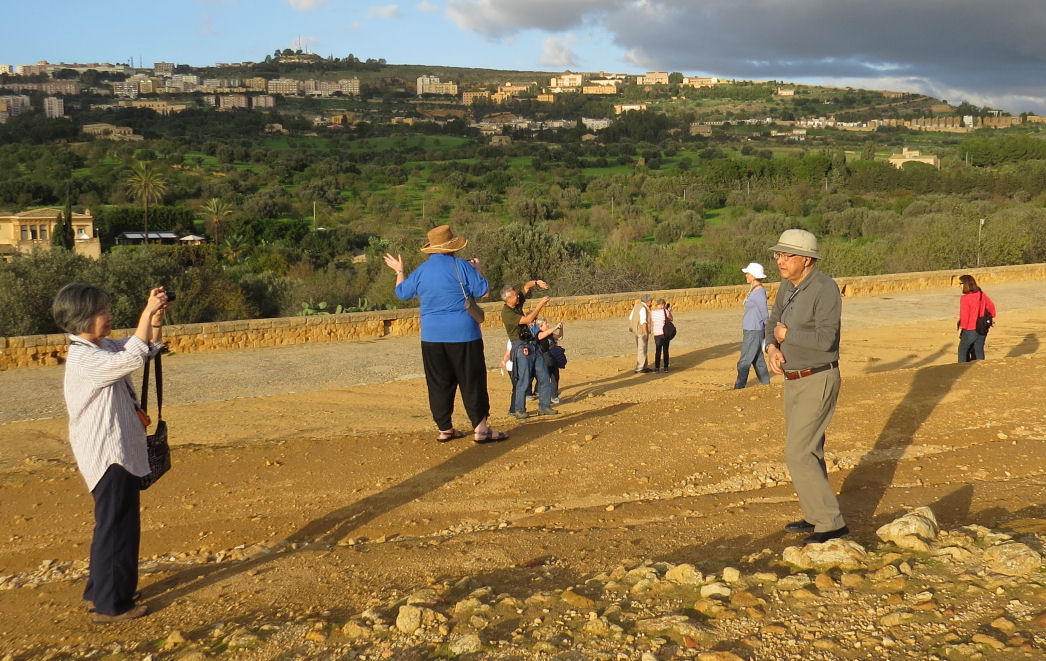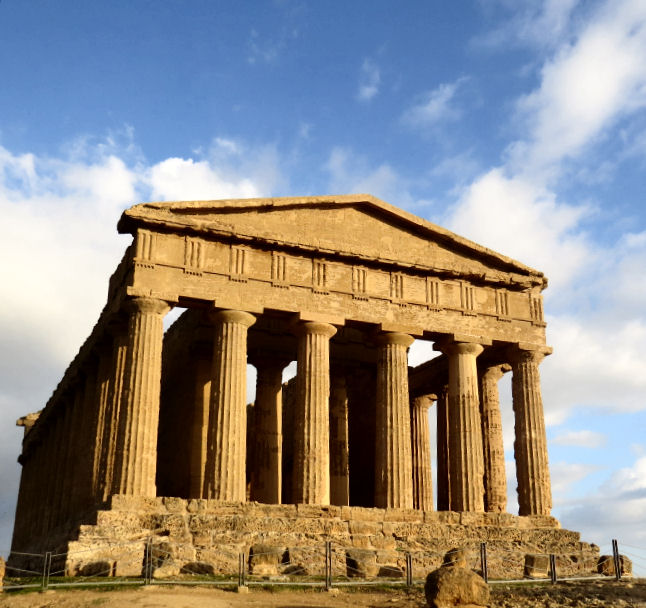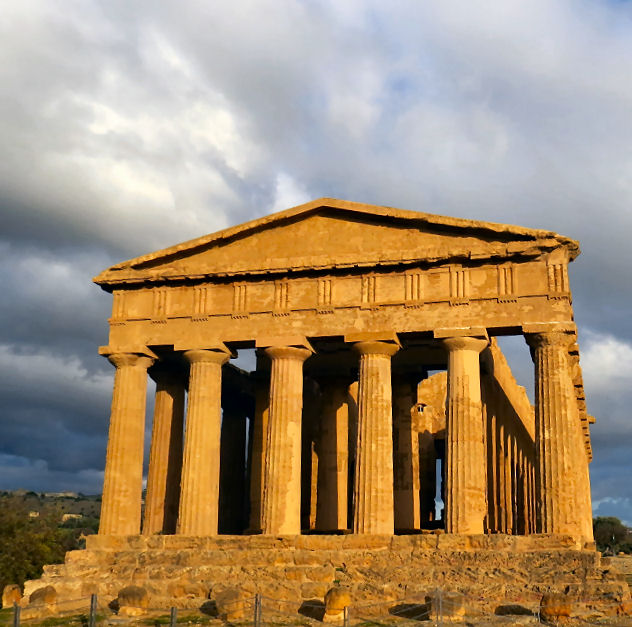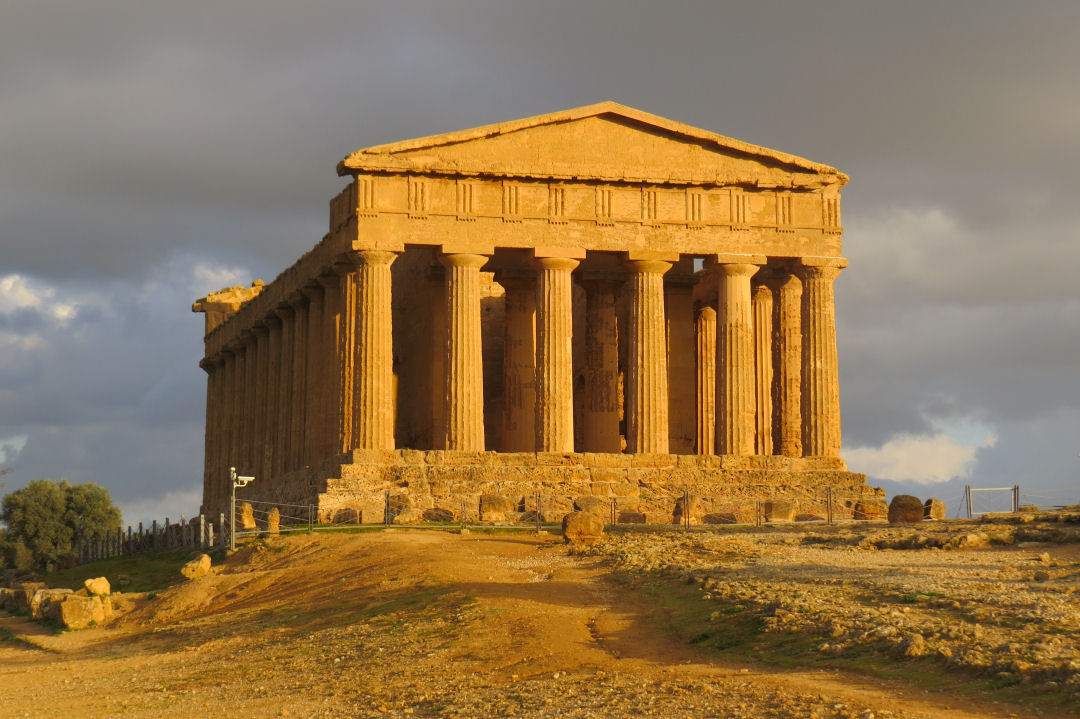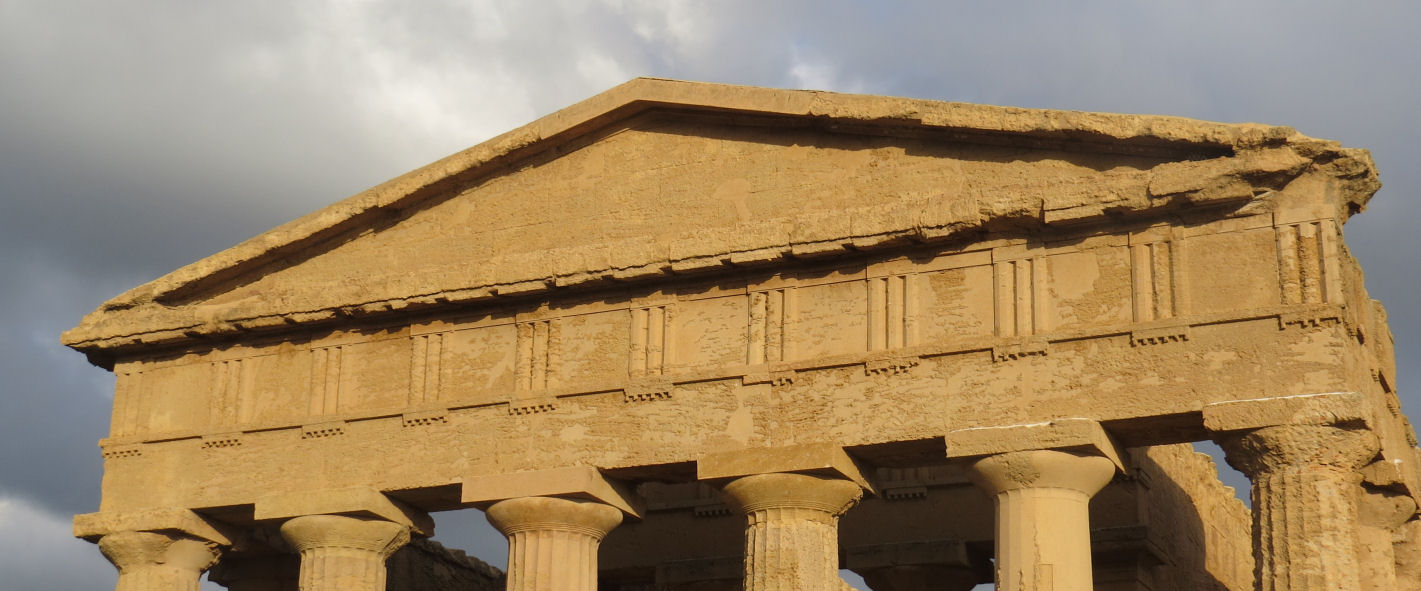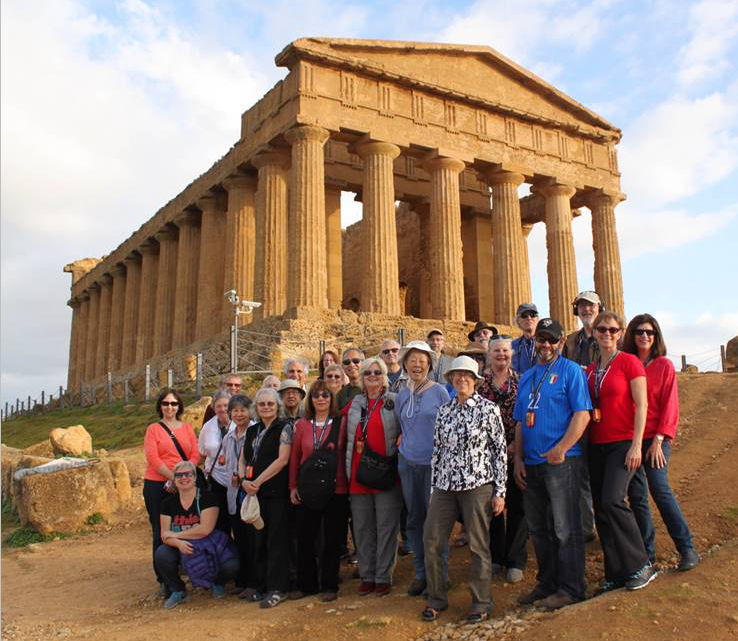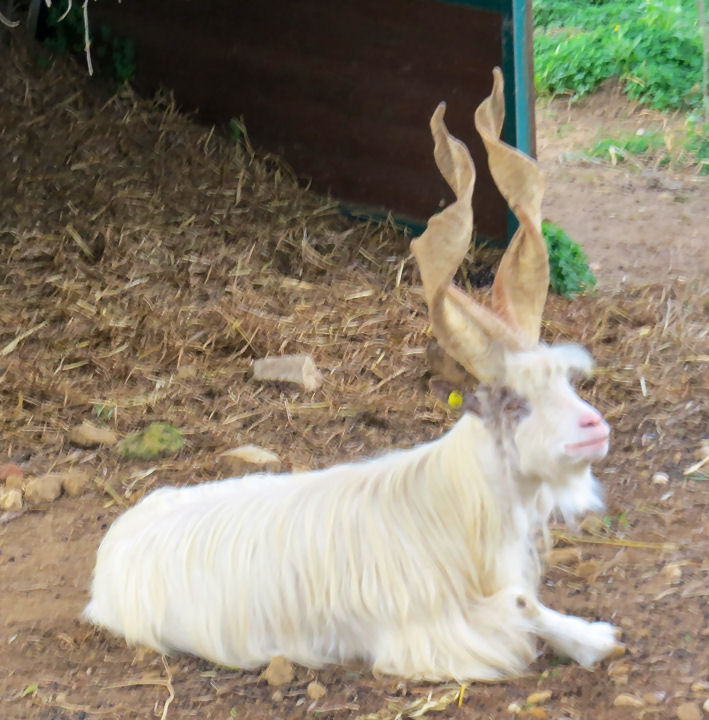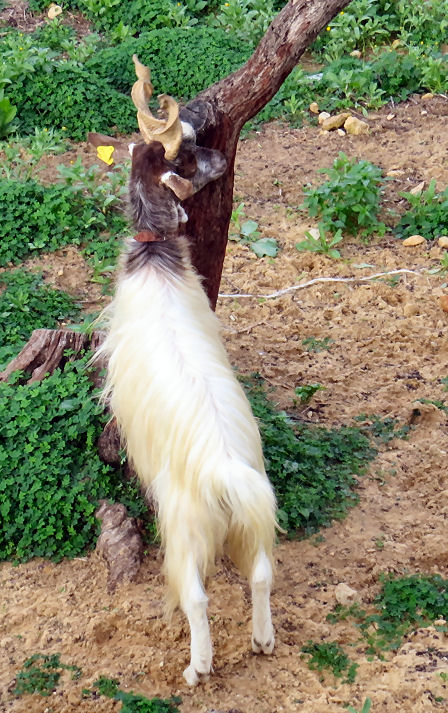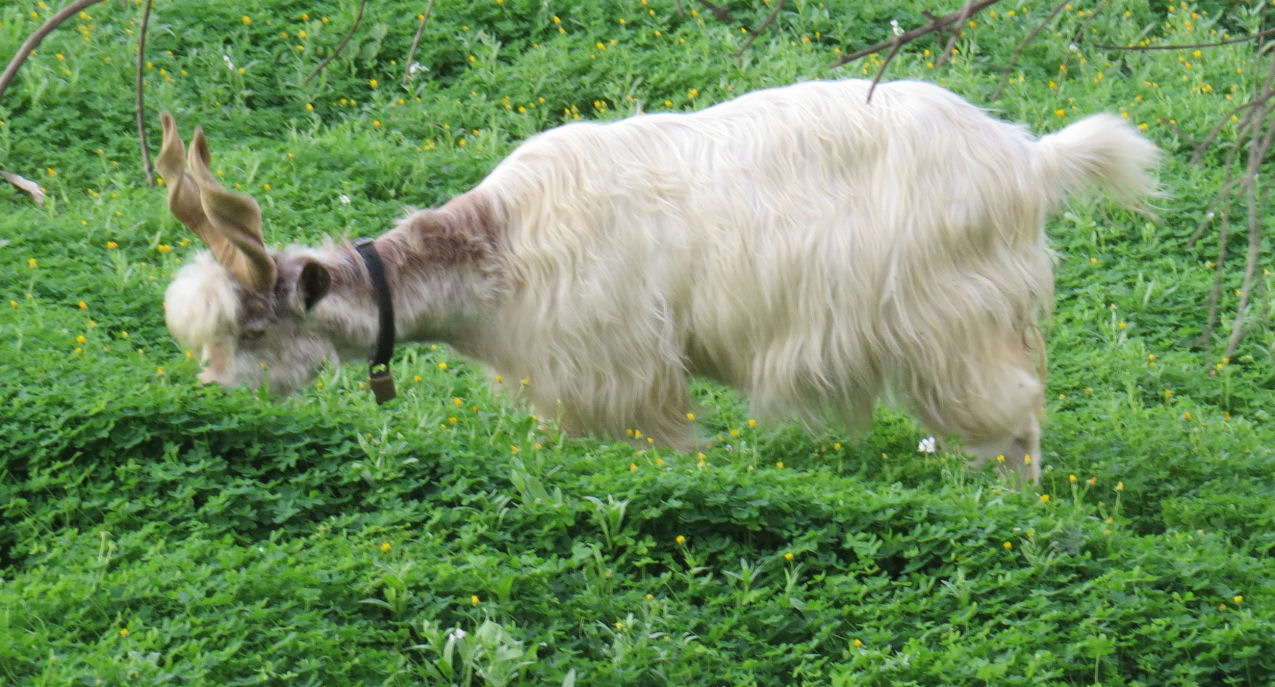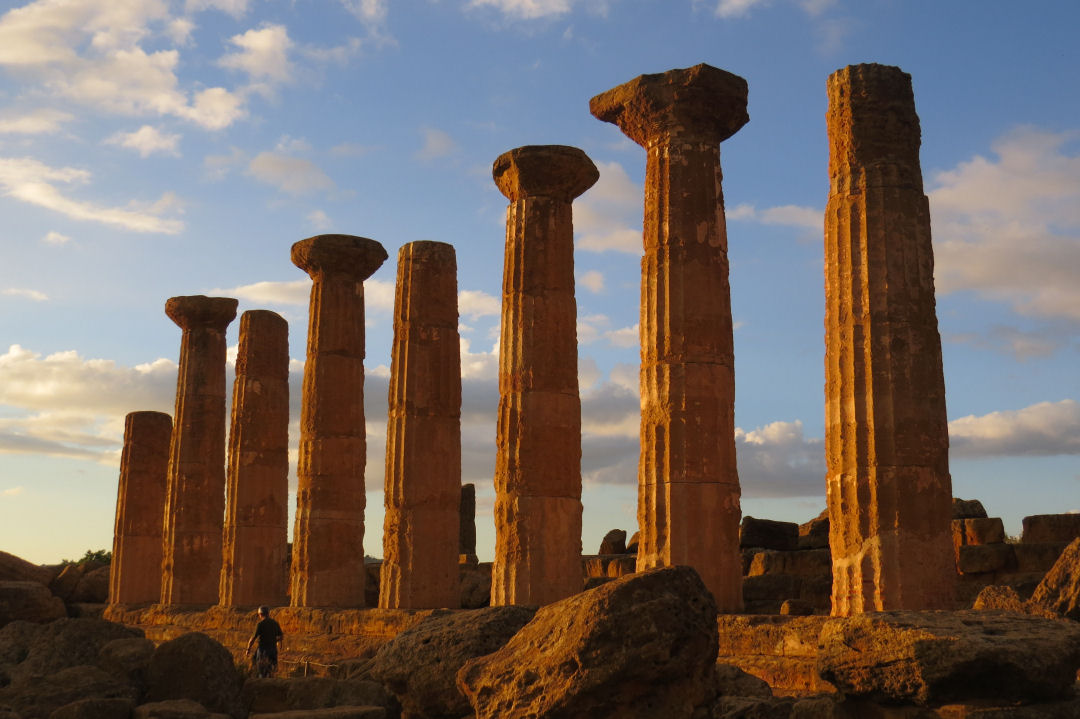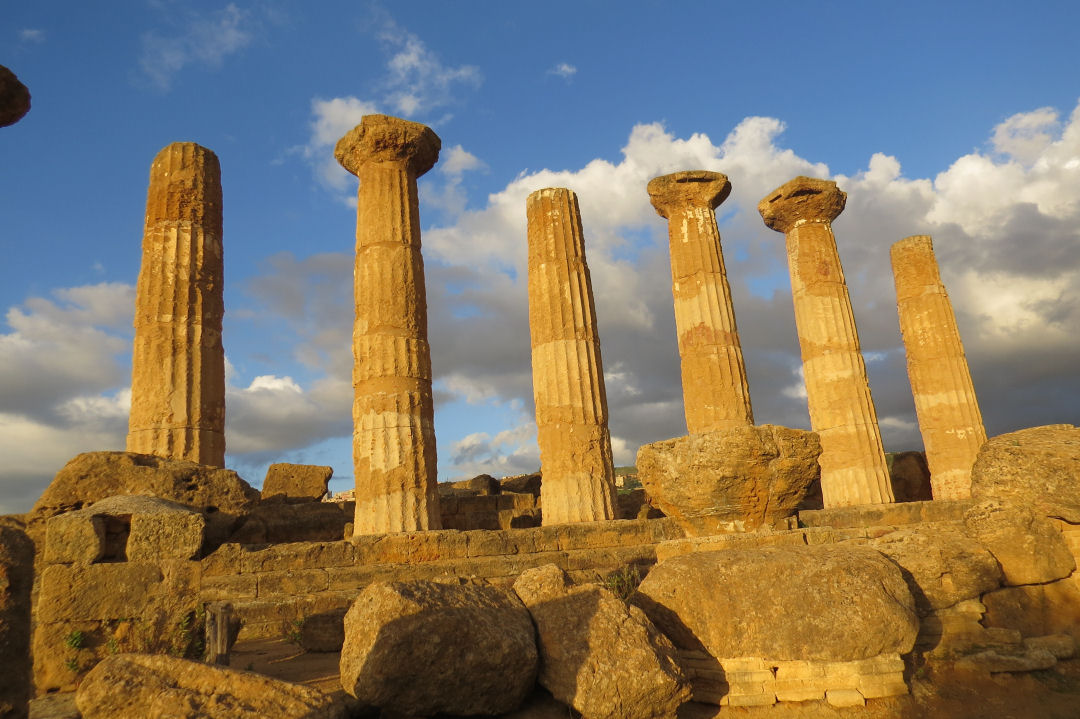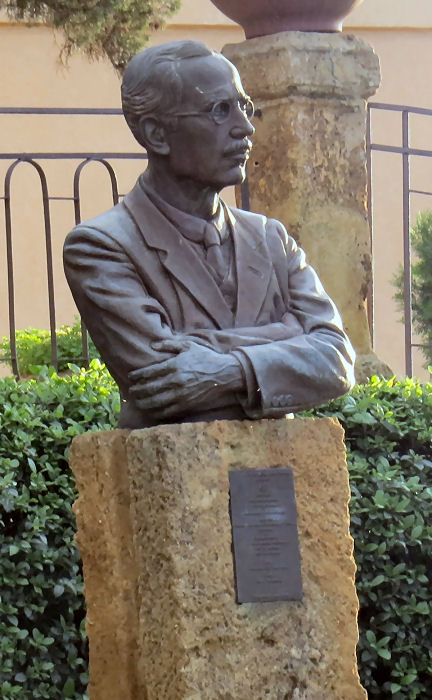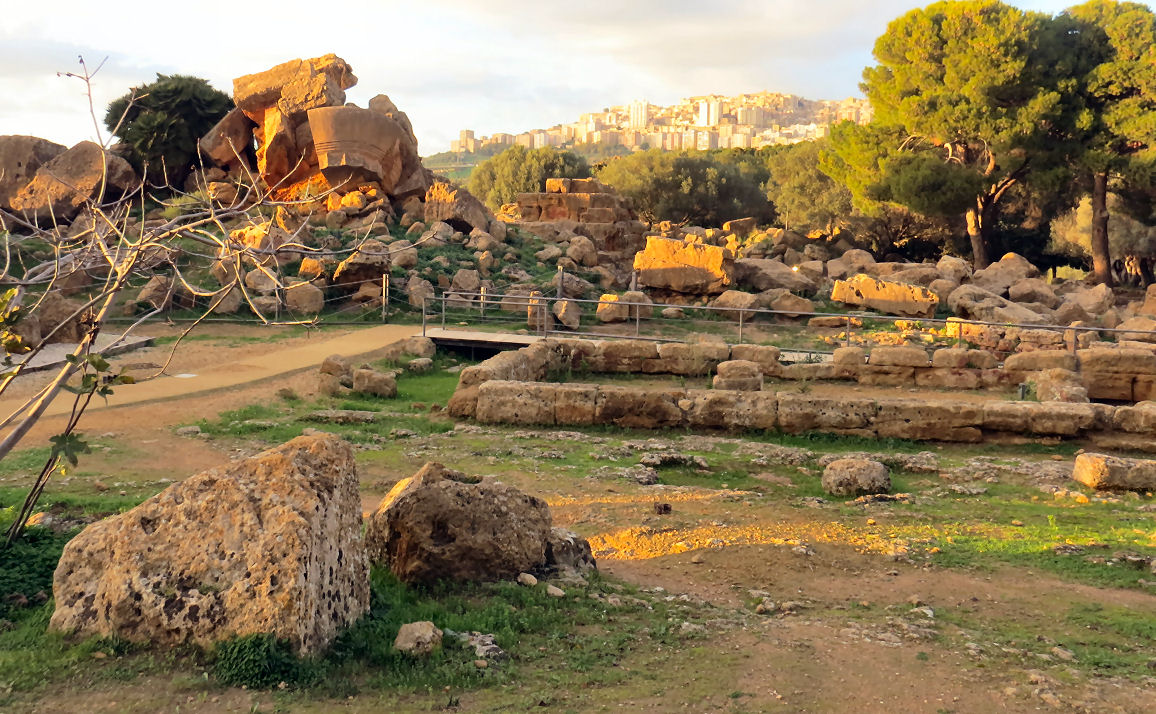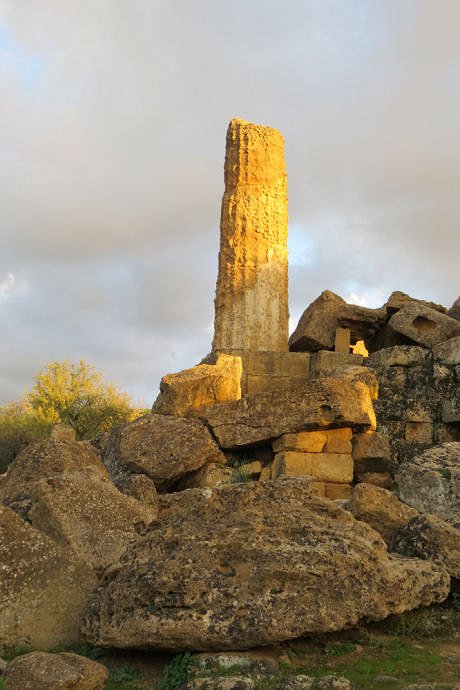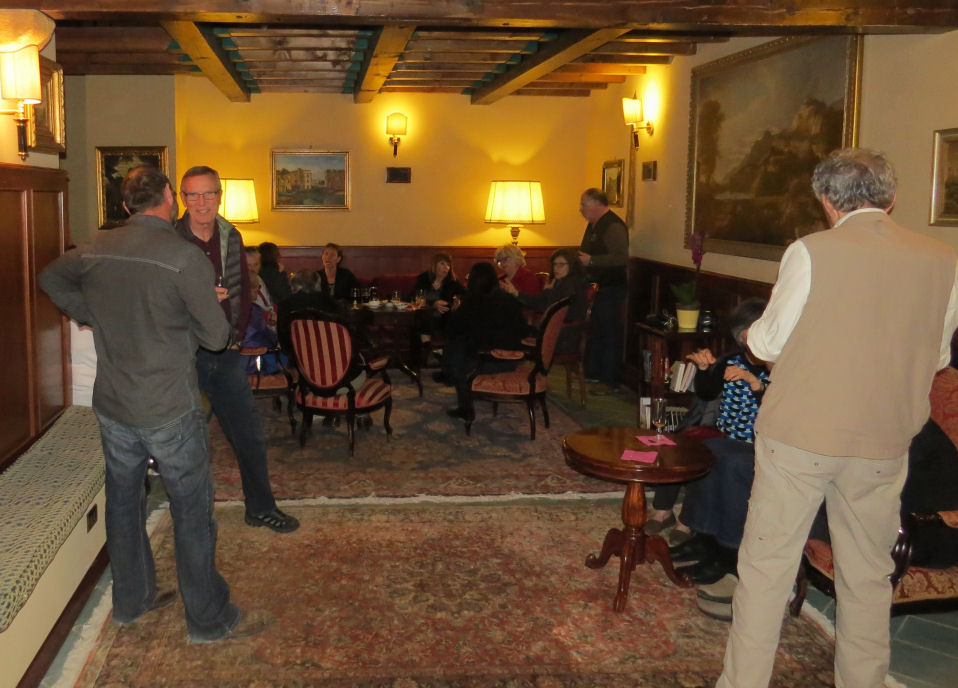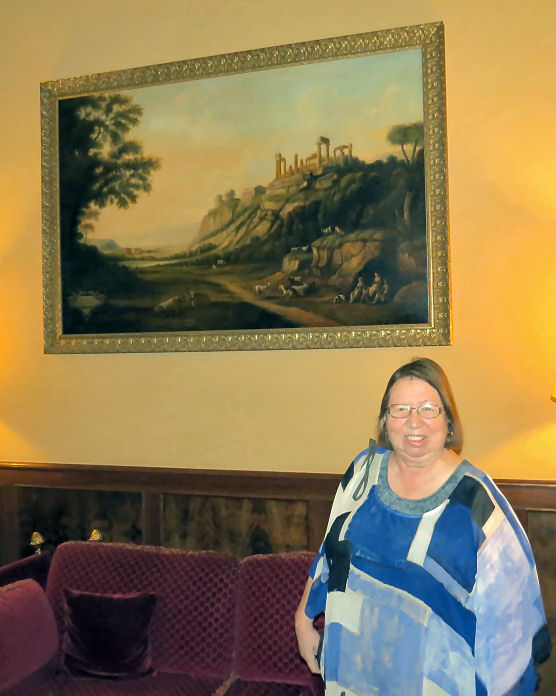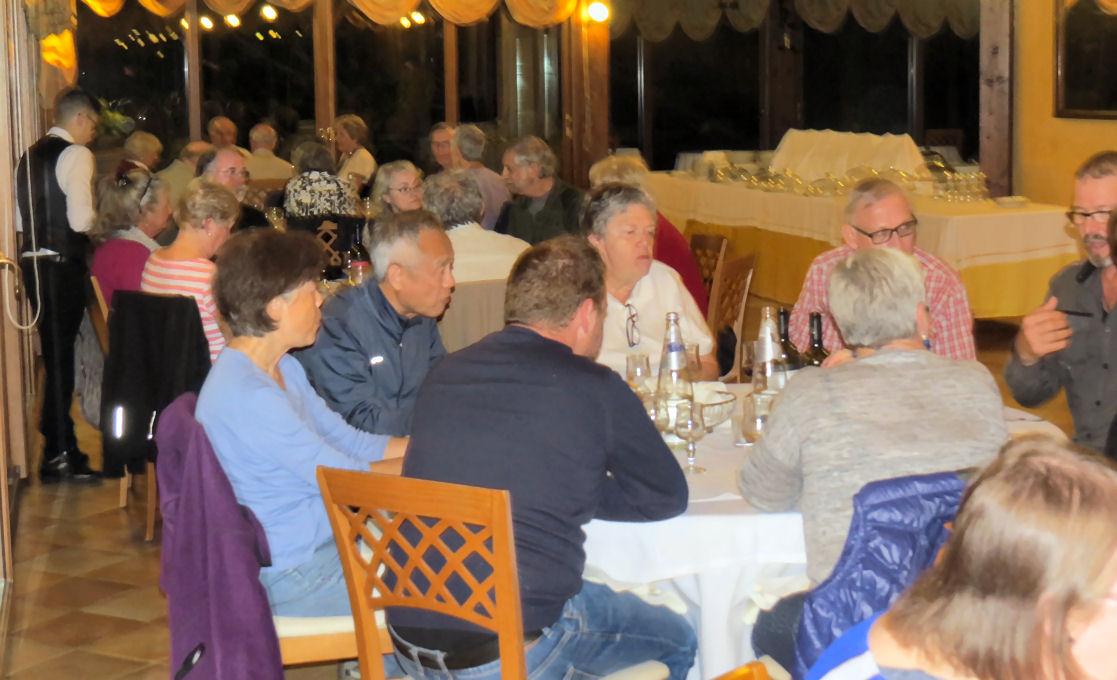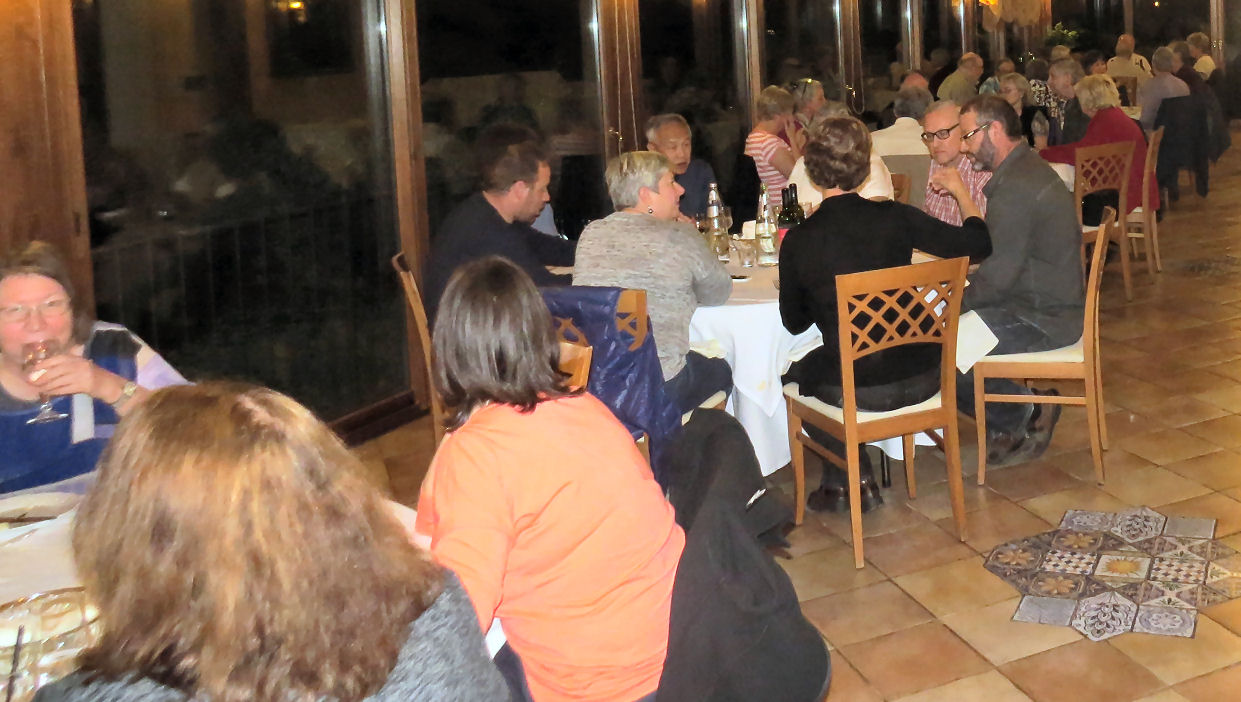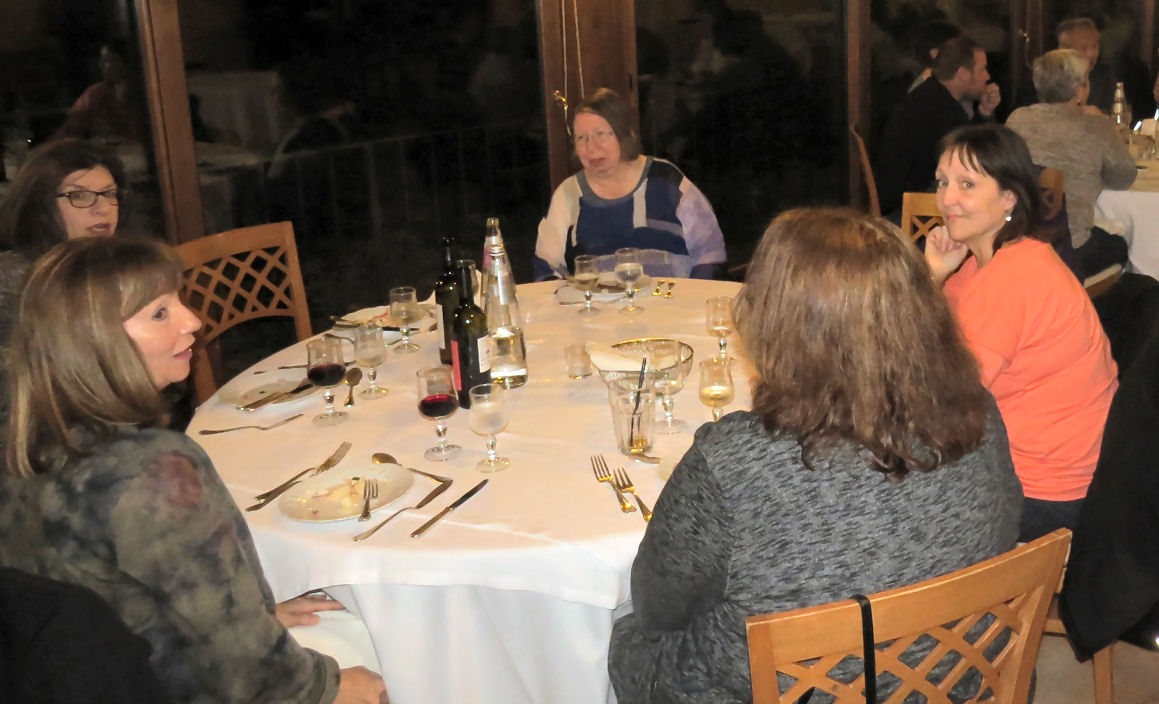I awoke at 3:30 in the middle of a bizarre nightmare about a giraffe. By chance I had come upon the corpse of one of the majestic beasts. It had been all hacked up into segments. There was no blood or any other kind of mess. I left to tell someone about it, and when I returned the giraffe parts were all gone. Fortunately, I was somehow able to get back to sleep for another two sleep units and did not arise until 6:30.
The plan for the day included some serious bus time. We planned to drive halfway across the northern coast of Sicily from Trapani to Agrigento, where we were scheduled to tour both the Archaeological Museum and the Valley of the Temples. We would stay one night in Agrigento and then move on.
I shared a table at breakfast with Emily and P.C. I started with eggs and bacon and topped it off with two bowls of cereal. I customarily ate only an apple for breakfast at home, but I also ate lunch quite early. I had found that when I traveled, whether on vacation or to bridge tournaments, eating a fairly large breakfast worked best for me. Part of this attitude was doubtless due to my well-established penuriousness: I almost never passed up free food.
I saw that Wendall was eating breakfast by himself next to us. He had been wearing a Pittsburgh Penguins hat, and I knew that he was from Canada. I therefore shared with him my experience during the only NHL game that I had ever witnessed. Sue and I had attended a basketball game in Hartford in 1981, and I happened to win the door prize, which was two tickets to a Hartford Whalers game. I was excited because Sue and I had no money to spend on entertainment at the time.
The tickets were for the very last game of the season, which matched the Whalers against the Penguins. In those days the NHL had nineteen teams, and sixteen made the playoffs. Both the Whalers and the Penguins had failed to qualify. In short, the game—between two of the three worst teams in the NHL—meant absolutely nothing.
The Whalers seemed to be playing pretty well, and “Brass Bonanza,” the Whalers wordless fight song blasted from the loudspeakers over and over. At the end of the second period the Whalers led. I think that the score was 3-1. In the fourth period the Whalers added another goal, and they held the hapless Penguins to only five shots on goal. Unfortunately, four of those shots slipped past the Whalers' goalkeeper, and the Penguins won 5-4.[1]
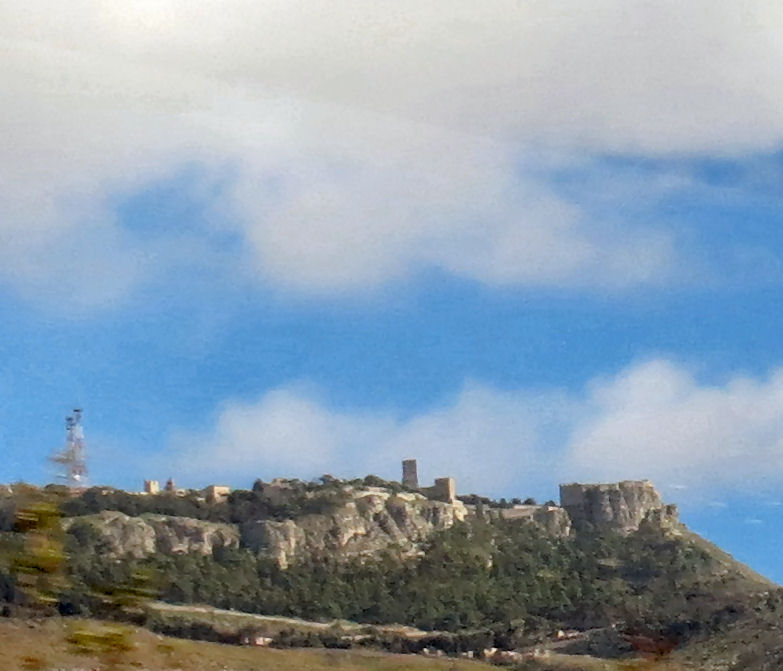
Wendall asked me if Mario Lemieux had played for the Penguins that night. I said that I doubted it, and I was right. His NHL career began in 1984.
Sue did not find time to eat breakfast. While I was recounting my only hockey story, she was cursing her suitcase, which, when fully packed, would not allow the handle to be fully extended. My suitcase, which was much larger than hers, had some free space. I volunteered to lug some of her stuff.
The sun was out! We had avoided the rain, but we had not seen the sun in some time.
We all turned our luggage over to Giuseppe and boarded his bus. We passed a bowling alley. I wondered if an establishment like that could actually succeed in Sicily. Only a relative few managed in the States.
I noticed that in western Sicily there seemed to be a lot of wind turbines but very few large trees. I wondered if the latter had been harvested. Perhaps the climate or soil was not suitable.
Susanna told us that our local guide in Agrigento would be Michele (mee KAY lay) Gallo. He would escort us through both the museum and the Valley of the Temples.
Susanna used the bus trip to impart some information about Italian and Sicilian history, culture, and politics. She began with the basic fact that Italy had only been a distinct country since 1871. At the time of the Risorgimento Sicily and southern Italy were run by the Bourbon family. The king was Louis XIV's grandson, Charles V.[2]
Sicily had for centuries been a predominantly agricultural country in which the oligarchs ran the farms. This arrangement continued after the republic was established until the 1950's when a program of redistribution of the land was initiated by the government. The famous book The Leopard by Giuseppe Tomasi di Lampedusa described the result from the perspective of one of the oligarchs. Susanna recommended it highly.Mussolini ruled Italy for roughly twenty years. He started his political career as a socialist, but he changed direction many times. He expelled the Savoy monarchs, titular rulers who had ceded political power to democratically elected officials at the time of the Risorgimento, when they criticized him. Il Duce was captured by a gang of partigiani in 1945 and executed along with his mistress.
After the war Italy benefited greatly from the Marshall Plan. The current constitution was enacted on January 1, 1948. Italy had become much more modern and industrial since the 1950's, when an incredible economic boom began.
At the end of the war two parties dominated Italian politics, the Christian Democrats, who represented the center-right, and the Communists, who represented the center-left. The latter distanced itself from Soviet-style communism when Enrico Berlinguer took over leadership in 1972. These were by no means the only parties. Italy has always had dozens of small parties.
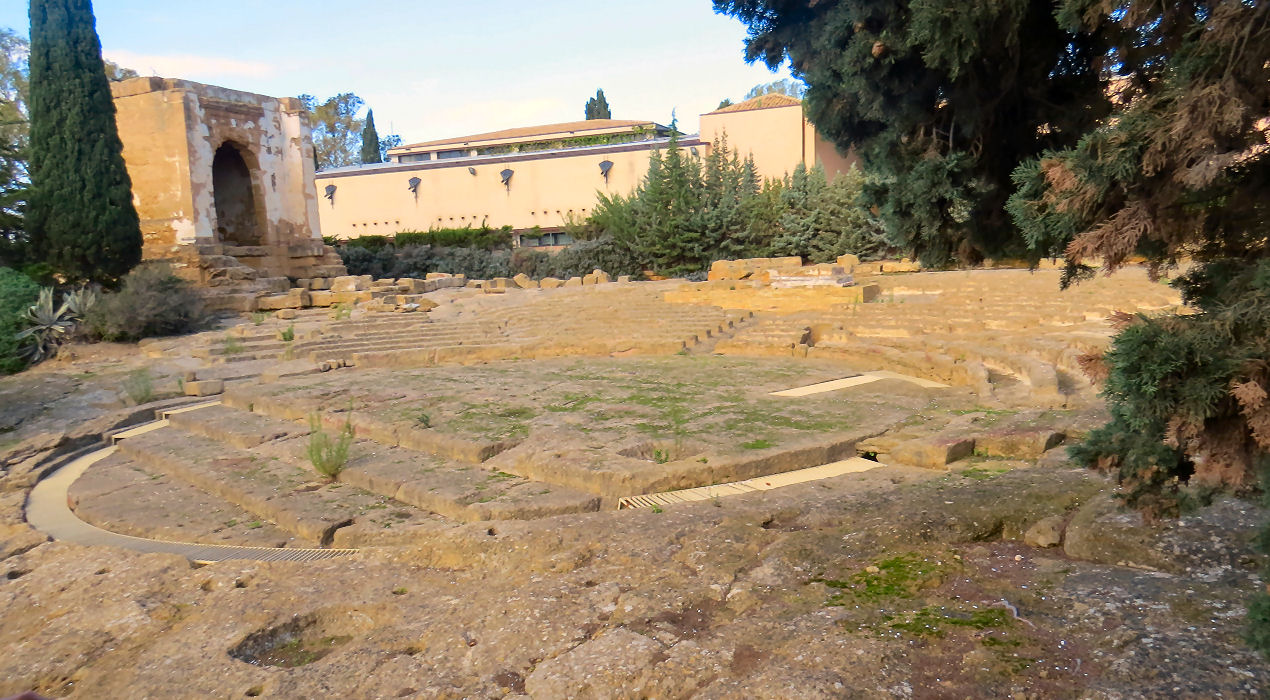
In the middle of the the seventies two big issues were divorce and abortion. The Lateran Treaty with the papacy explicitly prohibited divorce. Abortions were likewise illegal in Italy until 1978. Divorce became legal in Italy in 1970, but it was still rather difficult for divorcees (especially divorced women) to remarry.
The communist party evolved into the Partito Democratico, which in 2016 supported a watered-down version of socialism. The new force in Italian Politics was the Cinque Stelle movement led by former comedian Beppe Grillo. This party had demonstrated great appeal to the young and to the women. It had won mayoral races and enough seats in the parliament to be something of a force in a very divided government.[3]
Silvio Berlusconi had taken advantage of the the corruption scandal that befell Benito Craxi and many others in the late eighties.[4] Craxi fled to Tunisia and died there.
Berlusconi, a media magnate widely considered the richest man in Italy, stepped into the power vacuum. He formed a political party called Forza Italia that was effectively a populist cult of personality centered on himself. He made alliances with the former Fascists and the Lega Nord, a separatist party that campaigned for the formation of a new country out of the regions that are located north of Rome. This coalition ruled Italy off and on for about two decades.
When Berlusconi resigned for the last time, a new “technocrat” government was formed without a legitimizing election. This was at the insistence of the European Union in order to avoid the economic chaos that had stricken other European countries. The current government of Mateo Renzi, the former mayor of Florence was the third since that decision had been implemented. The first, headed by Mario Monti, an economist, lasted about eighteen months. Enrico Letta's government lasted only ten months. Renzi took power in February of 2014.
Susanna informed us that the unions were much less powerful in 2016 than they had once been. Free education and free health care had once been the norm in Italy, but the last few governments had been destroying all of those things. Italy still had no nuclear power plants, but it bought a lot of electricity from France.
Renzi had staked his reputation and his government on an attempt to change the Italian constitution. The vote was scheduled for December 4,[5] two days after the end of our tour. This and its implications were very difficult to understand. Susanna said that the main issue was what the changes would do to the Senate. Susanna said that it would “delete” it, but a more accurate description was that it would emasculate it. Other checks and balances would also be removed. Susanna worried that one of the intended results would be the privatization of electricity. She said that she had spent a lot of time researching this, and she planned to study it more after our tour was over.
At that point Giuseppe maneuvered the buss into a roadside establishment for a pit stop. Unfortunately, the place that we planned to use for our break was closed. Giuseppe had to make a U-turn. After a bit he found a place named Oasi Bar that was across the street from a McDonald's.
I looked up the phrase for “cough drop” in my Italian dictionary. I then went inside, noticed some Hall's behind the cashier's back, and asked him, “Avete pasticche per la tosse?” The guy immediately knew what I was after, and he quickly sold me a small package of an Italian brand. I thought about asking for the Hall's, but I figured that that might be considered rude, so I just paid him €1.30 and accepted the cough drops.[6]
Back on the bus Susanna embarked on a sidetrack lecture about olive oil. She said that Spain was the #1 producer of olive oil in the world, and Italy was second. Italy, however, had been much better at marketing internationally. Most regions of Italy, except the ones in the far north, produced olives. Olive trees cannot stand frost, and they do not produce any fruit for the first twenty years of life. However, in a mild climate they can last for thousands of years.
In Spain the olive harvest began in October and could last until February. In Italy it began in late November or December and continued through January. The olives were crushed pits and all into a paste. A centrifuge was then used to separate out the liquid.
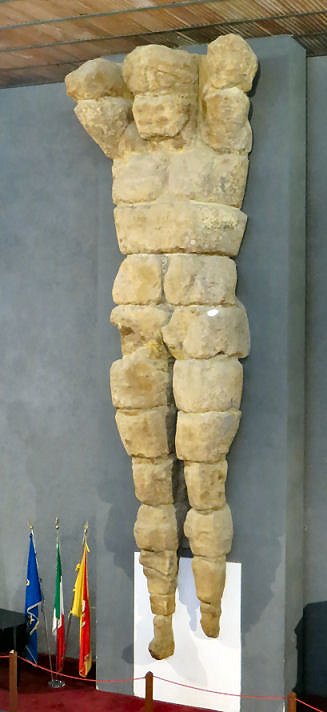
As we passed field after field of farmland Susanna resumed talking about the referendum. The Italian parliament at that time consisted of a Senate of 315 members and a Chamber of Deputies with 630 members. Passage of a bill required approval by both houses. The proposed change would drastically reduce the size and role of the Senate.
I asked Susanna whether Berlusconi was for or against the constitutional amendment. She said that he had recently come out against it.
Another diversion involved the discussion of an amulet of a little red horn called a “cornetto.” For the Romans it was a symbol of fertility. In Italy it was still commonly worn, but as a token of good luck.
Giuseppe had to stop the bus for a minute or so at a one-way bridge.
From the bus we could at last see the Valley of the Temples off to our left and behind it the modern city of Agrigento up on the hill. When we arrived Susanna introduced us to Michele the guide who would escort us through the Archaeological Museum and then the Valley of the kings.
By the time that we got off of the bus it was about seventy degrees outside. It was by far the warmest day of the entire vacation. I left on my sweater, but I stuffed my jacket into my backpack. Sue got down to a tee shirt.
The museum, which was built on the site of an old Cistercian monastery, was opened in 1967. The Greek town's agora was on the hill. The theater was found after two hundred years of excavation. The building incorporated the remains of the cloister into a very modern exhibit hall. When Michele showed us the cloister he said that had once featured a fountain.
Michele dispensed an immense amount of information. I did my best to keep up with him, but sometimes my notes,[7] were very sketchy. One great thing about the museum was that the exhibits were in chronological order, which made it a little easier to get a feel for the timeline of Agrigento's history. We also greatly benefited from the fact that we were there during off-season. The museum was not at all crowded. This made it a lot easier both to follow Michele's explanations and to take unobstructed photos.
He began by telling us about Phalaris, the first “tyrant” of Akragas, which is what Agrigento was called during the Greek period. He lived in the sixth century BC. He was very powerful; in fact he conquered most, if not all, or Sicily. However, he was so cruel that the very word “tyrant” came to have a pejorative connotation.
Michele said that the Sicani were considered the oldest know inhabitants of Sicily. They were evidently cave dwellers from Spain who may have arrive in the third millennium BC in the early part of the Bronze Age.
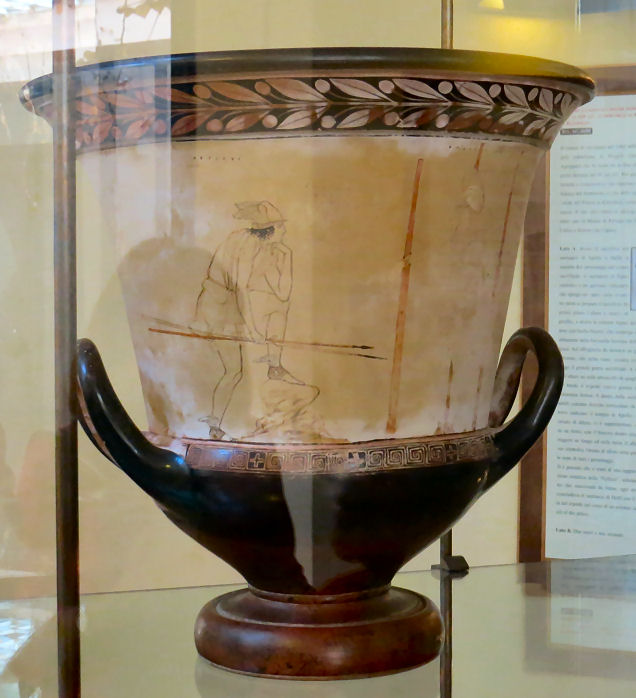
Evidence had surfaced that the Mycenaeans arrived in Sicily before the other Greeks. They did not sail directly straight across the sea; instead their vessels hugged the coastline and often put ashore in order to trade. Mycenaean water jugs, made on potter's wheels, were found in Agrigento, as well as a “fibula,” which Michele called a safety pin.
The ancient legends of Minos, the king of Crete, Daedalus, and Icarus were sometimes intertwined with Sicilian stories. The name of the Sicani king Kokolos was found in one recounting of the myth of Daedalus. In Agrigento a considerable amount evidence of contact with the Minoan civilization was uncovered including sulfur used for tanning and wine-making and bitumen used for tar, shipbuilding, and kilns.
A Mycenaean tomb found in Agrigento dated from the eighth century BC, two hundred years after Mycenae was destroyed. So, evidently the buried individuals were colonists.
The first Greek colony in Italy was Naxos, a town on the east coast of Sicily north of Catania. The Greeks evidently came from Rhodes and Crete. They used olive oil for cleansing, fuel, and on their food.
Michele said that the use of the three running legs, the Trinacria, as an emblem of Sicily dated back to the seventh century BC. After World War II the outlaw Salvatore Giuliano, who was at the center of the movement aimed at secession for Sicily, adopted the symbol for the MIS, Movement for an Independent Sicily.
Akragas was the name of both the the river and the city that was the fist Greek settlement in Agrigento. The settlers probably came from Rhodes, but they needed women.

The Montalbano novels were set in the fictional district of Montelusa, which was based on Agrigento.
The Greek pots were made of red clay. Figures were painted on them in black. Later the process was reversed. The blank space was painted black to give the appearance of red figures on a black background. The Greeks often painted scenes of mythological stories. Dionysius, satyrs, and Pegasus were popular. Michele told us about a “symposium” in which the men got together to play a game that involved flicking drinks at a target. The winner received a courtesan as a prize.
One of the pots was bilingual. It told the story of the death of Patroclus, Achilles's BFF, at the hands of Hector. The idea of the soul leaving the body was developed by Pythagoras. The Greeks used their most precious vases as cremation urns.
In 1939 a law was passed preventing the exporting of artifacts. 230 items were sold by someone (Panitter?) to Bavaria.
The term “Italiate” refers to Greeks living in Italy in places such as Apulia or Paestum. They developed methods to mass produce the urns with the same scenes.
Amphora containers were recovered from shipwrecks. Some made of white clay were found intact, but the colors faded. They were used to water pigs. Depicted on them were Perseus and Andromeda. Perseus could be identified by his winged sandals. Andromeda was chained to a rock, but Perseus rescued her.
The big urn depicted Apollo with Daphne, who was turned into a laurel tree. Laurels were given as prizes, which led to the English word laureate. The priestess at Delphi claimed to be able to communicate with Apollo, who allegedly resided in a sacred laurel tree at his temple there.
The Greek temples had wooden roofs. The rain spouts were the heads of lions that served the same function as gargoyles in Gothic architecture.
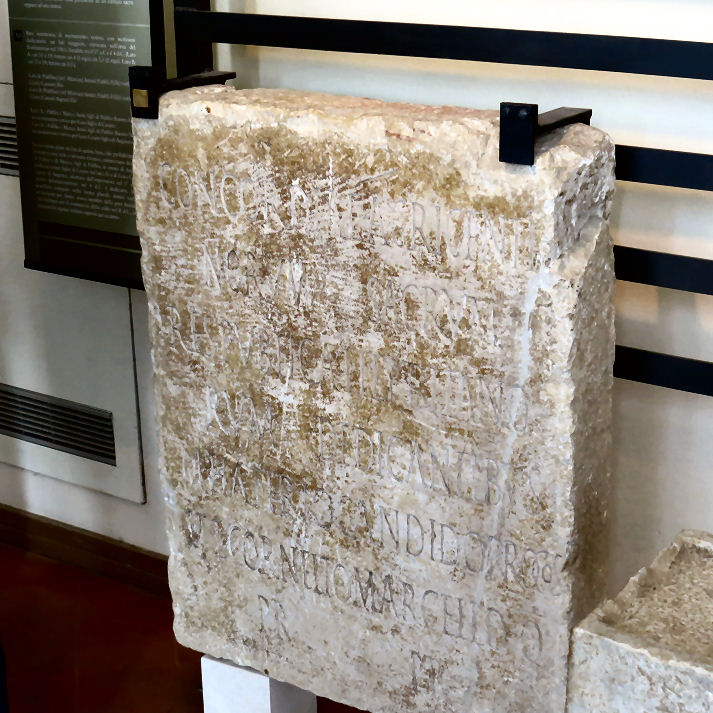
“Ex votos” were small items that were offered to the gods. The temples had so many of these that the priests apparently hid the old ones in pits.
The huge stone statue came from the temple of Zeus. The 25-foot statue was assembled in 1825. Thirty-eight statues had been found. The temple was one-hundred ten feet high, three times as large as the Parthenon. The statue was called “Atlante” because it appears to be supporting the temple on its shoulders. The statue's features appeared vaguely African, but it may have been intended to represent all races. It was coated with white plaster and probably painted. The tile came from the ridge of the roof.
The kouros, which means young man, was carved from marble, probably in Greece. The base and pedestal of the statue have been provided with anti-seismic elements. If I understood correctly, Michele said that the statue had apparently been discarded. The Romans took the rest of the Greek sculptures when they came to Agrigento.
During the Roman period most of the sculptures depicted actual heroic figures, including the bust of Emperor Hadrian.
Both Jews and Christians were buried in catacombs. Some of the burial sites could be seen in the Valley of the Temples.
An ancient document literally carved in stone has been interpreted as a treaty between the cities of Marsala and Agrigento. It was found near the temple of Concordia, which was named in its honor.
Several sarcophagi were on exhibit in the museum. A woman's was tall and rich. A child's sarcophagus was found in pieces in a dump.
The agora in Agrigento was almost as big as the one in Athens. It had six avenues and thirty side streets.
We took a break for lunch at La Promenade dei Templi.[8] The sign on the building said “Ristorante Bar,” but we only saw the bar part. We had to stand in line to order lunch, and I had to wait for at least fifteen minutes. Some locals came in and, of course, jumped the line by giving the high sign to one of the employees. All I wanted was two slices of pizza and a Coke Zero. When I finally got to the front of the line, the lady got them for me in seconds.
I was enjoying the weather more than the food as Sue and I sat on the front porch. Then some very noisy people came up and sat at the table next to us. I could not take it any more. I walked down to where we were supposed to meet the bus in a few minutes, sat on a stone wall, and took a few pictures. Eventually Giuseppe and the bus arrived to take us down to the Valley of the Temples.
The temples were the most important structures in Greek society. There were at least fifteen of them in the valley. Carthaginian slaves were probably forced to build them. It required only seventy-three years to construct all fifteen of them. No good evidence has been uncovered to determine which gods were associated with which temple. Archaeologists have nevertheless assigned names of gods to them.
We started at the westernmost temple, which allowed us to walk downhill for most of the way. The first one that we encountered was the Temple of Hera (Juno to the Romans). Michele explained that the common people were not allowed inside the columns. That area, which was known as the cella, was restricted to the priests. The temple itself was known as the fanum. The altar, where sacrifices were made, was in front of the temple, where the worshipers congregated. That area was called the profanum, the source of the English word “profane.”
The columns in the temples were in the Doric style. All the temples were built using the same basic pattern. Dowels were place between the columns. A temporary ramp was constructed around the structure. Pulleys and wheels were used to lift at the far end. U-shaped indentations allowed for the insertion of ropes. White plaster was applied to the columns to protect them from the elements. The interior was red because of the oxidation of hematites (rust to you).
Michele told us that most of the trees in the valley were almonds. In this part of Sicily almonds were harvested in July or August.
Remnants of the city walls could be detected throughout the valley. The walls that encircled the ancient city were approximately seven miles long and included nine gates. In the fifth and sixth centuries AD the lower part of the city was abandoned, probably because of outbreaks of malaria. It was turned into a necropolis, a burying area. There were family tombs under the arches.
The Temple of Concordia and the temples in Paestum were the best preserved Greek temples in the world. The Temple of Concordia was constructed between 435 and 430 BC. There must have been an altar in front of it at one time.
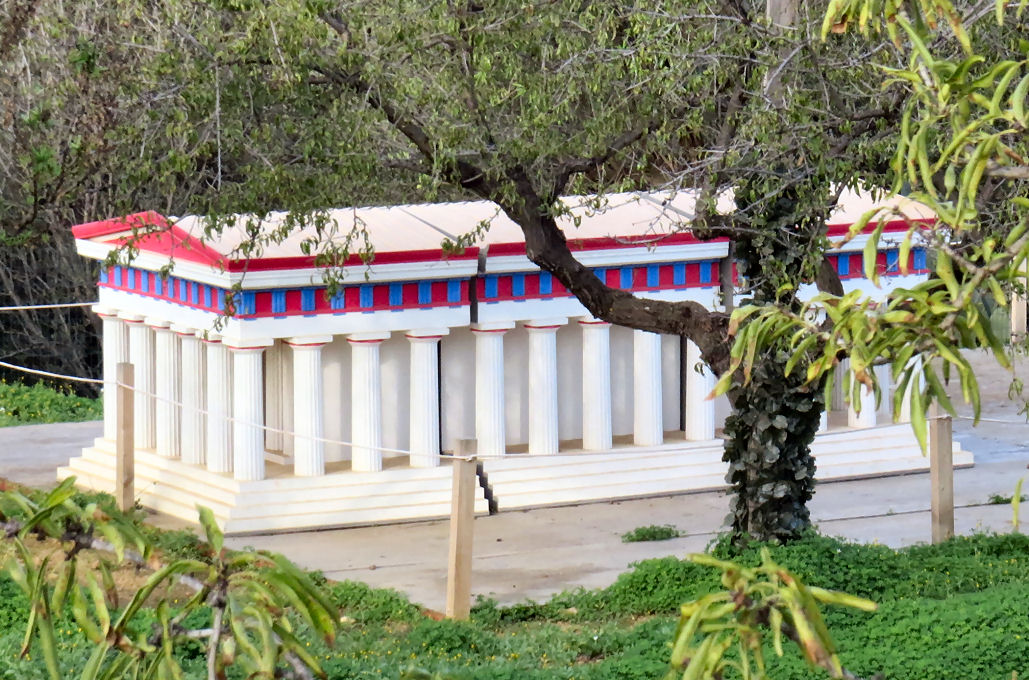
In 597 the temple was converted into a basilica to Saints Peter and Paul by the Bishop of Agrigento. The process required twenty years. The walls were knocked down, and the entrance was moved to the west side. I took a lot of photos.
Everyone gathered together for a group photo. Michele served as photographer. He used Leslie's camera.
Greek temples were not as symmetrical as they appeared. The columns led in with a small slant. This caused a problem known as the “Doric corner conflict.” In Agrigento it was addressed by adjusting the space between the last columns. The temples were made from sandstone. They were completely lacking in relief sculptures. The coloring and the roof timbers were missing. They had gutters and rain spouts.
The biggest surprise of the afternoon was an encounter with a trio of strange-looking goats. Michele told us that they were Girgentana goats imported from Balochistan.
Much of the restoration of the Temple of Heracles was due to the efforts of one man, Alexander Hardcastle. He purchased the Villa Aurea in Agrigento in 1920 and began massive excavation, restoration, and renovation works.
The Temple of Zeus, which has never been reconstructed, was 370 feet long and 180 feet wide. The calculation was based on the size of the column pieces that were dispersed about the area. Michele emphasized again that it was approximately three times the size of the Acropolis.
He ended his presentation with a quote from a man whose grandfather and great-grandfather had been presidents of the United States. Henry Adams once called Agrigento “Athens with improvements.”
It was only a short walk from there to Giuseppe's bus, which took us to our headquarters for the night at the Fosteria Baglio della Luna. Sue and I were entrusted with the key to room #202.
After a few minutes to unwind and unpack we walked across the courtyard to the hotel's restaurant. We had a very nice supper there with the four ladies from Texas: Diane, Ann, Laurie, and Leslie. Sue regaled everyone with stories of her previous trip to Sicily with her father-in-law,[9] Chick, who was of Sicilian descent.
To my taste the food itself was of mixed quality. I did not care for the appetizer, which was a combination of orange, onion, and fennel. The pasta course was something twirly in a red sauce. The secundo consisted of cod, potatoes, tomatoes, and olives. An almond mousse was served for dessert. The last three were all pretty good, but not exceptional.
The other topics of conversation were the devastating landslides in Cinque Terre in 2011 and a strange tale of an evening that Laurie and Leslie had spent with some people on, I think, a previous trip. For some reason Laurie came back after the meal and appeared to them outside of the window adjacent to where they were sitting. She pretended to ride a pony and made everyone laugh.
I enjoyed a few glasses of wine at supper; I may not have gotten all the details right.
[1] I have told this story many times, but this is the first time that I have published it. I was happy to determine on the Internet that the Whalers actually did lose that game by the score that I remembered.
[2] Not to be confused with the powerful Emperor Charles V. This Charles was also King of Spain, but in Spain he was known as Charles III. He was also known as Charles VII of Naples.
[3] I think that Susanna missed an opportunity to explain Grillo's invective against the “political class” in Italy. Because of the way elections were structured there the leaders of the party were almost assured of being elected every time, and they had usually acted like it.
[4] Most Americans do not comprehend how widespread corruption was in Italy. Susanna could have explained this better. All four parties in power in 1992 eventually disappeared!

